#Residential Steel Roofing
Explore tagged Tumblr posts
Text
Cost Efficiency of Residential Steel Roofing
Choosing the right roofing material for your home can be challenging, especially when considering factors like durability, cost, and weather resistance. For those looking for a robust and economical option, residential steel roofing stands out as a top choice. In this blog, we'll explore why steel roofs are a cost-effective solution for homeowners.
Weather Resistance and Cost Savings
Steel roofs are known for their exceptional weather resistance, offering a longer lifespan compared to traditional roofing materials. Made from sturdy components, steel roofs can withstand harsh weather conditions, including snow, heavy winds, and rain. Properly installed steel roofs can endure winds of up to 140 mph, making them a reliable choice in areas prone to severe weather. This durability means fewer replacements over time, saving homeowners significant costs on maintenance and repairs.
Longevity and Durability
One of the most significant advantages of steel roofing is its durability. A well-installed steel roof can last many years, providing long-term value. Additionally, steel roofs often come with a protective coating that reflects sunlight, helping to keep homes cooler and reduce the need for air conditioning. This can lead to lower energy bills and substantial savings. Steel roofs are also fire-resistant, potentially lowering homeowners' insurance premiums due to the reduced risk of fire damage. Their resistance to impacts, such as hail, further reduces potential damage and insurance costs.
Energy Efficiency and Cost Reduction
Steel roofing contributes to energy efficiency by reflecting solar radiation, which helps keep homes cooler. This reflective property decreases the reliance on air conditioning, resulting in energy savings and lower cooling costs. Moreover, adding insulation between steel roofing panels can improve a home's overall insulation, maintaining a comfortable indoor temperature year-round. This can lead to reduced heating and cooling expenses, providing further financial benefits.
Considerations for Choosing Steel Roofing
While the benefits of residential steel roofing are numerous, it's essential to consider the initial cost, environmental impact, and aesthetic preferences when deciding if it's the right choice for your home. Although the upfront investment may be higher than other materials, the long-term savings on maintenance, energy, and insurance can make steel roofing a wise investment.
For more information, visit - https://www.clarkroofingtx.com/.
0 notes
Text









INVISIBLE STUDIO - HOUSE IN AN OLIVE GROVE
#INVISIBLE STUDIO#architecture#residential#holiday house#concrete#steel structure#minimalism#indoor outdoor#building in landscape#gable roof
1 note
·
View note
Text
Best Steel Roof Installers Near Me
Our company specializes in providing top-quality steel roofing solutions in Canada, catering to both residential and commercial clients throughout the province. If you’re searching for the best steel roof installers near me, you’ve come to the right place.

Residential Roofs
Upgrade your home with metal or steel roofing by best steel roof installers near me. Choose from sheet, tile, slate, or shingle styles, ensuring your roof fits your preferred aesthetic without sacrificing quality.
Metal roofing has become increasingly popular among homeowners and businesses due to its durability and longevity. Although the upfront cost of installing a metal roof is roughly double that of asphalt shingles, the long-term savings make it a worthwhile investment.
History
Lead and copper have been important architectural materials for thousands of years due to their durability and ease of use. Lead, a by-product of silver smelting, was abundant and affordable in Roman times, while copper was used in ancient structures like the Pantheon and Sri Lanka’s Lovamahapaya Temple. Copper remained significant in European medieval architecture, with notable examples such as St. Mary’s Cathedral in Hildesheim and Kronborg Castle.
In the 19th century, iron became more widely used due to its availability and lower cost compared to lead and copper. Techniques like coating iron with tin or zinc were developed to prevent corrosion, leading to the popularity of terne for roofing. Henry Palmer’s invention of corrugated metal sheets in 1829 revolutionized roofing by making it lightweight and strong. Corrugated galvanized iron (CGI) became globally popular after the patent expired, and with the advent of steel production, thinner but equally strong materials were produced.
In the 20th century, CGI roofing, initially seen as low-status, regained prominence through its use by architects like Walter Gropius and Albert Frey, who incorporated corrugated steel and aluminum into modern designs, restoring its architectural significance.
Type of Metal Roof Panels:
Metal panels are usually made from steel or aluminum and come in interlocking or overlapping designs, with various coating options. The material type and panel style you choose will influence the total installation cost. Read more...

#metal roofing installation#metal roofing suppliers near me#residential steel roof installers near me
1 note
·
View note
Text
Commercial roof repair in Asheboro NC: Learn how to strengthen and maintain your commercial roof for durability and longevity.
#epdm roofing installation#roof repairs#roofing contractor#tpo roofing contractor#commercial steel roofing#commercial roof installation#residential roofing
0 notes
Text
Unveiling the Excellence of Steel Fabricators in Melbourne.
Introduction: In the bustling city of Melbourne, steel fabrication plays a pivotal role in shaping the landscape of construction and infrastructure projects. Steel Fabricators Melbourne stands as a beacon of excellence in this domain, providing unparalleled services to meet diverse project needs.
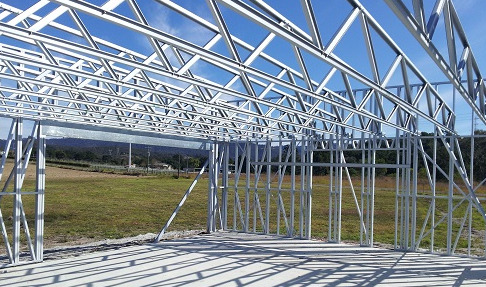
Expertise in Structural Steel Fabrication: Steel Fabricators Melbourne boasts expertise in structural steel fabrication, offering tailored solutions for residential, commercial, and industrial projects. With state-of-the-art facilities and a team of skilled professionals, they deliver high-quality steel structures that adhere to stringent industry standards.
Custom Fabrication Solutions: From intricate architectural designs to large-scale industrial frameworks, Steel Fabricators Melbourne excels in providing custom fabrication solutions. Their ability to translate client requirements into precise steel components sets them apart in the industry.
Quality Assurance: Quality is paramount at Steel Fabricators Melbourne. Each steel component undergoes rigorous quality checks to ensure durability, strength, and compliance with project specifications. Their commitment to quality assurance instills confidence in clients, making them a preferred choice for steel fabrication needs.
Timely Delivery and Cost-Effectiveness: Steel Fabricators Melbourne understands the importance of timelines and budget constraints in project execution. With efficient project management practices, they ensure timely delivery of fabricated steel components without compromising on quality. Moreover, their competitive pricing makes them an economical choice for clients across Melbourne.
Conclusion: Steel Fabricators Melbourne stands as a cornerstone in the realm of steel fabrication, offering unmatched expertise, custom solutions, and unwavering commitment to quality. Whether it's a residential construction project or a large-scale industrial endeavor, clients can rely on their proficiency to deliver exceptional results. With a track record of excellence and client satisfaction, Steel Fabricators Melbourne continues to shape the skyline of Melbourne with their precision-engineered steel structures.
For More Information Visit - https://skybluesteel.com/
Contact US - Phone - 0418777345 Mail Id [email protected] Timings -9AM-5PM (monday-Friday).
#Steel Fabricators Melbourne#Residential Steel Fabricators#Steel Wall Framing System#Roof Trusses Melbourne#Floor Joists For Sale
0 notes
Text
Featuring the Importance of Roof Coatings and the Benefits of Cedar Shake
This article aims to provide comprehensive answers to all your questions regarding roofing, including steel roofing, roof moss removal, and related topics.
When it comes to roofing options, metal shingles are a popular choice among homeowners in the United States. They are readily available, versatile, and cost-effective. However, it's important to explore other functional roofing alternatives, such as green roofs and solar shingles, despite their higher price tags.
Why is Roof Coating Important?
Are you considering installing roof coating for your home?
The cost of replacing a roof can be quite substantial. As a homeowner, it's natural to want to minimize expenses as much as possible. Fortunately, roof coating offers more than just an extension of your roof's lifespan.
This treatment provides a range of benefits that you may not have heard of before and shows how investing in roof coating is a must. It's not just about reducing heat energy; roof coating also acts as a waterproof layer with UV protection, safeguarding your roof from the detrimental effects of materials breaking down due to prolonged exposure to ultraviolet rays and heat.
The greatest advantage, however, is that roof coatings ensure strength and longevity for your roofing components while preserving the attractive appearance of any structure.
Are there any other advantages to expect from roof coatings?
Absolutely! The success of roofing professionals lies in their emphasis on clear communication throughout the entire roofing process. Many homeowners feel apprehensive about having a new roof installed, fearing that something might go wrong.
A properly done roof coating protects you from all unfavorable weather conditions. Professional roofing experts are equipped with state-of-the-art techniques and tools that can provide the best solutions for your roof.
It is worth mentioning that roof repairs are generally less expensive than a complete roof replacement. Although a roof replacement may initially cost more, as the saying goes, "a stitch in time saves nine." It will save you money in the long run by minimizing the need for future repairs.
Here are some key considerations when considering a roof replacement:
Natural Damage: Minor hail or wind damage can often be repaired, such as fallen limb scars. If your roof is only a few years old, repairing or re-roofing a section may be a cost-effective alternative to a complete roof replacement.
Leaks: Modern roofs employ materials like tar and rubber around vents and pipes. However, these materials tend to degrade faster than the roofing material itself, leading to leaks. Fortunately, they can be easily replaced if water is leaking at these spots.
Installation Problems: Large amounts of tar covering flashing indicate poor workmanship and can lead to major issues. A professional roofing company can easily install the missing items at a lower cost than a new roof.
Improper Ventilation: If you notice condensation on the underside of your roof deck, plywood in the attic, or difficulty in keeping the second story temperature cool on hot days, your attic may require better ventilation. Technicians are ready to assess your home's venting needs.
Signs Your Roof Needs Replacement: Certain roof conditions cannot be repaired, necessitating the replacement of the entire roof. Factors such as age and degeneration play a significant role:
Age: Asphalt shingle roofing should be replaced every 15 to 20 years. As you approach that age, yearly inspections are necessary to determine when to replace it.
Degeneration: Roofs endure the effects of sunlight and various weather conditions. Curling or shrinking shingles, an abundance of shingle granules in the gutters, bare spots, algae growth, or extensive moss are indications that a roof replacement may be needed.
The type of roof is also important when considering a replacement.
Steel roofing rightfully claims a firm place in today's market as a popular roofing material choice. Here are a few perks of steel roofing:
Durability: Stainless steel, known for its corrosion resistance, offers high strength resistance and excellent resistance to thermal shock. It outlasts all other roofing materials, but it may come at a higher cost.
Safety: The stainless steel grades commonly used for roofing have a higher melting point than other roofing metals, providing additional safety for your roof.
Low Maintenance: Due to their long-term corrosion resistance and smooth surface finishes, most stainless steel roofs require minimal maintenance, making them a cost-effective choice in the long run.
Let's now delve into the benefits of cedar shake roofs. If you're seeking a unique roofing option for your new construction or looking to upgrade your current roof, cedar shakes are an excellent choice.
Cedar shakes are simple roofs made from high-quality cedar wood, providing a rustic and earthy appeal to your home. They have been a popular roofing option for decades for several reasons:
Aesthetics: Natural wood offers a timeless and appealing look that surpasses metal shingles and asphalt. As cedar shakes age, they develop a unique dark brown hue, adding a touch of architectural charm to your home.
Energy Efficiency: Cedar shakes provide natural insulation, reducing the need for excessive air conditioning and lowering heating and cooling costs. They are a wise investment that adapts to changing climatic conditions.
Eco-Friendly: Cedar shakes are environmentally friendly as they come from a renewable source—trees that can be replaced once they have fallen. The production of cedar shakes also minimizes waste materials.
In summary, making wise decisions to protect your investment goes a long way. Choose the roofing product that best suits your residential or commercial building and opt for the most professional roof replacement contractors. Keep an eye on your needs and select wisely.
#roof replacement#commercial roofing#roof leak repair#roof inspection#steel roofing#metal shingles#cedar shake#roof coatings#roofing installation#roof repair#residential roofing#roof moss removal
0 notes
Text
Excerpt from this story from CNN:
William Fulford moved from Virginia Beach, Virginia, to a new waterfront development in Florida in 2023. Nestled between Sarasota Bay and the southwestern part of Tampa Bay, the new home by Bradenton Beach was everything Fulford, a retired custom homebuilder, ever wished for.
The developers of the new Hunters Point community, Pearl Homes, billed the property as the first “net-zero” single-family home development in the US, meaning residents produce more energy from solar panels than they need, with the excess energy either being stored or sold back to the grid – in a state where most electricity is generated by burning natural gas, a planet-warming fossil fuel.
They also boast some of the most sustainable, energy-efficient and hurricane-proof homes in the country: The streets surrounding the homes are intentionally designed to flood so houses don’t. Power and internet lines are buried to avoid wind damage. The sturdy concrete walls, hurricane-proof windows and doors are fortified with a layer of foam insulation, providing extra safety against the most violent storms.
Climate resiliency and storm protection were built into the fabric of the homes. And while the newly developed homes have endured a few storms since people moved in around February 2023, Hurricanes Helene and Milton put those features to the true test over the last two weeks.
Most of the residents living in Hunters Point heeded the mandatory evacuations ahead of Hurricane Milton’s landfall but Fulford, 76, stayed behind with wife, Sueann, just as they did during Hurricane Helene last month.
They stocked up on water and groceries. Fulford moved the car to higher ground. He tied up all patio and back deck furniture together. They brought everything from the garage, which made up the entire ground floor, up to the living spaces on the second floor. And, in the event of a worst-case scenario, Sueann insisted on getting life preservers.
“I’m just quite convinced that the strength and everything in this house. They built a great house, a strong house,” Fulford said. “And I just feel comfortable. I feel like we’re high enough up, even if we get a storm surge.”
When Gobuty started the design process for Hunters Point, it was imperative the homes be able to withstand Category 5 hurricanes. It’s the first residential development to get a Leadership in Energy and Environmental Design (LEED) net-zero certification in the world, according to the US Green Building Council.
Each of the three-story homes are designed like this: The ground floor is a garage designed with flood vents to drain rising water. The living spaces start on the second floor, which is intentionally built 16 feet above sea level. From the roof to its foundation, steel straps secure the entire structure. Solar panels are attached to the roofs’ raised vertical seams to prevent them from flying off.
The property also sits in a major flood zone, which meant the homes needed to be elevated to meet Florida’s building codes. Still, the developers went beyond the required 3 feet of fill dirt and used 7 feet instead to be safe.
17 notes
·
View notes
Text

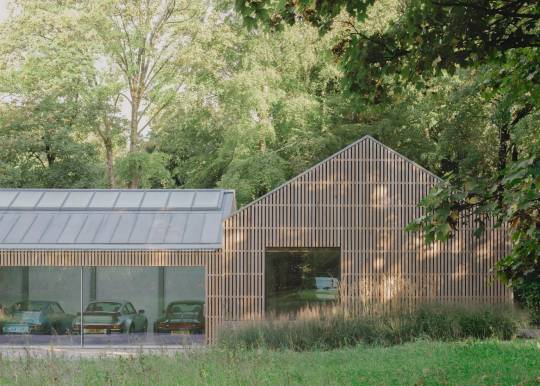


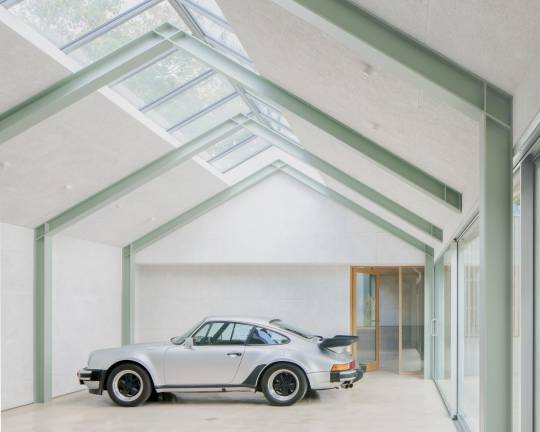


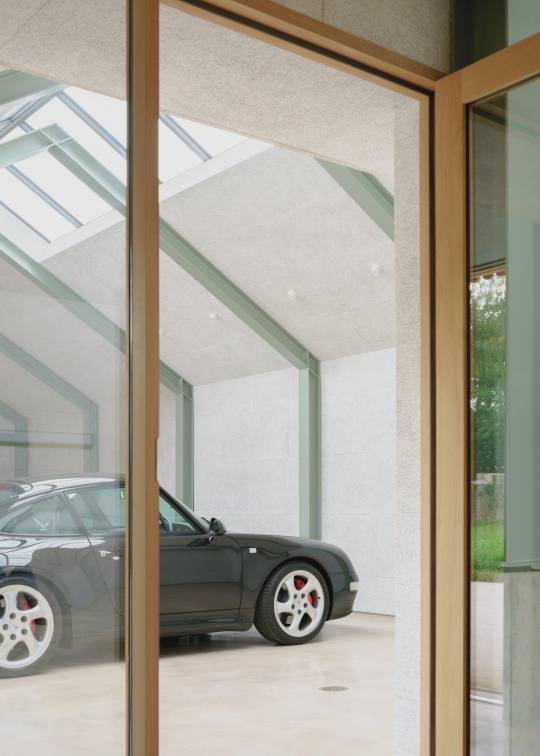
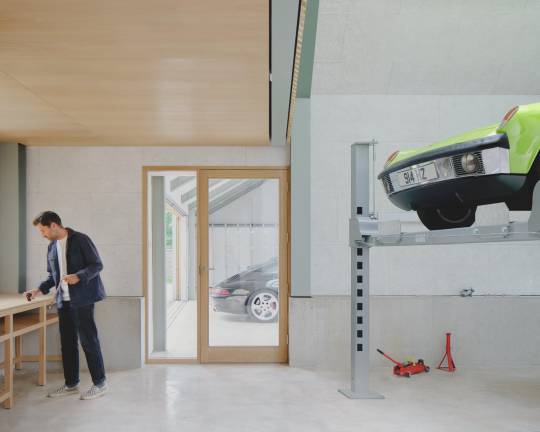



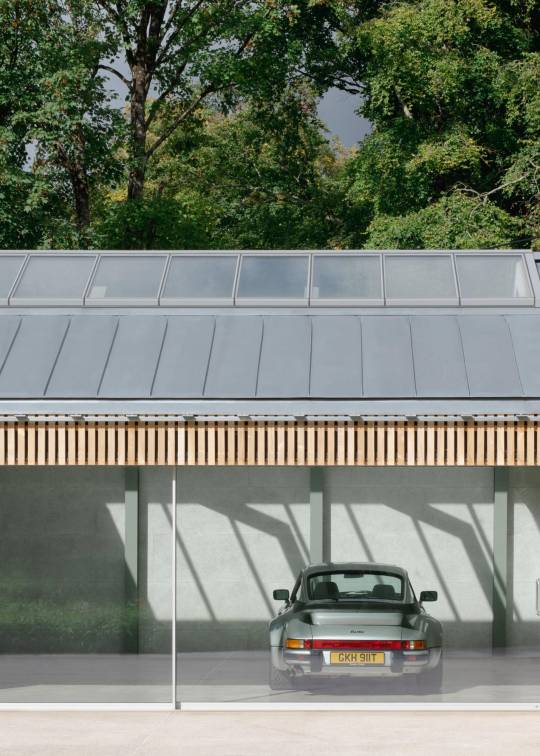
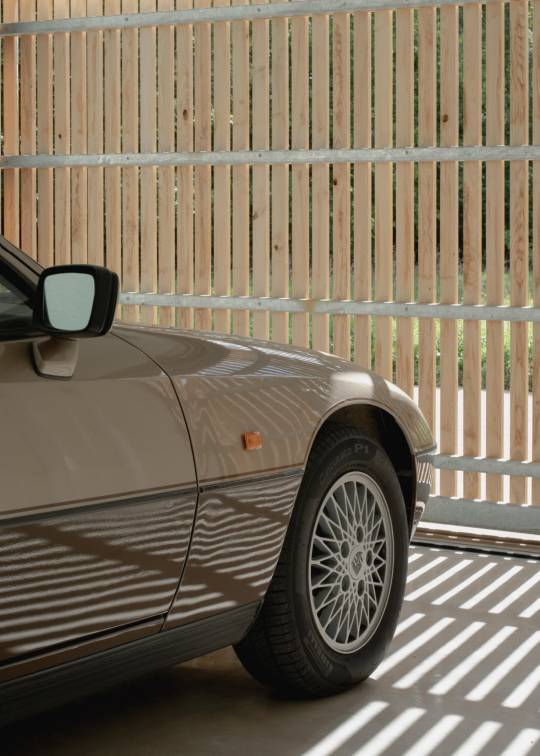


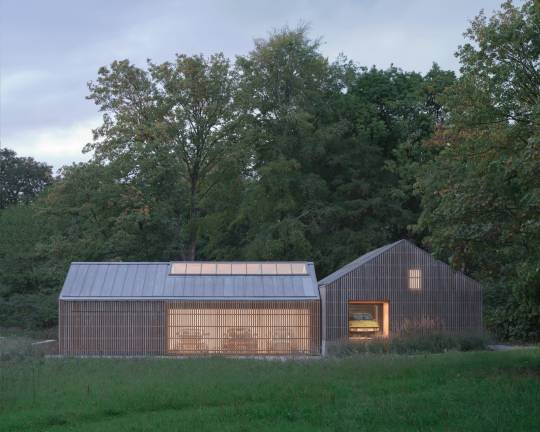
Autobarn by Bindloss Dawes
The Autobarn is the realisation of our client's long-term dream to house his collection of classic German cars. The project is composed of two volumes: a clean, five-bay garage for everyday use and a taller workshop for repairs and future restoration projects.
Beyond satisfying this initial use, the project ambition was to create a flexible, 'long-life, loose-fit' building that could be used for a range of different uses. Currently it doubles up as event space, however the ambition is that the Autobarn could one day become a low-energy house.
Located on the outskirts of a small Somerset village, the project is set within the grounds of an eighteenth-century Grade 2 listed house. It replaces several haphazard outbuildings and consolidates their amenity into an elegant architectural proposal, nestled within a glade of mature trees.
The project's design references the language of neighbouring agricultural barns. As a practice we are interested in reassessing the rural vernacular, both for its contextual appropriateness and its lessons in low-cost, pragmatic design. As such, the Autobarn re-interprets simple forms and methods of construction, adapting more temporary, rudimentary methods into a robust and elegant paradigm for low-cost, rural architecture. Composed of a concrete base and steel framed structure, intermittent timber cladding and zinc metal roof, the Autobarn adapts barn typologies with varying levels of refinement. Consideration was also given to its weathering, with the natural zinc roof dulling to complement the silver patination of the sweet chestnut cladding.
Like many barns, permeability to light and air is controlled through a series of movable layers. First experienced as a closed solid mass, the barn walls open up via a number of doors, including an heroic 7m sliding timber screen. The intermittent timber slats of the screens create internal dappled light during the day, which is reversed at night as interior lighting illuminates the surrounding landscape. Internally the steel structure is expressed in an array of simple portal frames, with sustainably-sourced wood-fibre acoustic board forming internal wall and ceiling. The garage space is calm and gallery-like, while the workshop space presents a tougher, taller workshop, surrounded with concrete wainscotting and designed to accommodate a car lift.
The building's 'long-life/loose-fit' ambitions have meant that the insulation and energy performance exceed residential standards. Although thermostats are currently turned down for its current use, the building includes underfloor heating powered by an Air Source Heat Pump, as well as additional first fix services hidden behind the internal wall paneling for future conversion.
Construction started in November 2020 and was completed at the end of 2021, with the project effected by the global pandemic and building material inflation. Despite these challenges, and the inclusion of some one-off expensive items (such as the electric garage doors), the Autobarn was built for under £2,300 / m2. In tandem with high energy performance and the use of natural materials, it combines our studio's goal to combine beauty, affordability, and sustainability.
Design: Bindloss Dawes Location: Frome, United Kingdom Area: 165 m² Year: 2022 Photography: Building Narratives
#architecture#gable roofs#garages#barns#british barns#british garages#united kingdom#bindloss dawes#building narratives#interiors
34 notes
·
View notes
Text
A Scintillant Spectacle
"Did you hear?" asked a young Hyune male to an Eldite woman with whom he was conversing, "There's been a whole slew of challengers wanting a piece of the action in the Arcadion since it reopened!"
"As if I'd miss a single beat of the know!" the Eldite replied with a chuckle, strolling down True Vue amidst a crowd of other Alexandrians. "I hear tonight's match wasn't planned, but it should be nothing the Gem Lancer can't handle!"
Solution Nine - the popular residential district within Everkeep - was apparently abuzz with rumors of an upcoming shotgun match with one of Alexandria's renowned fighters taking on a yet-unknown combatant. The sheltered people living within the electrope dome were practically starving for entertainment - any means of escape from the recent tragedy of their beloved Queen Sphene. With the revival of the Arcadion (pun not intended), however, that need would be assuaged. Along with new connections beyond the dome being made possible, the Alexandrians now had the opportunity to explore a realm as foreign to them as it would be for those coming into Yyasulani. And whilst some embraced this monumental shift, others could not dare to turn down a spectacle of martial and magical prowess the likes that only the Ascension Arcadia Championship could provide.
Within the confines of the great tower which loomed over True Vue, a woman slowly made her way down a long, dark tunnel, her strides slow, confident, and dignified - the hallmarks not unlike that of a princess's. As her footfalls echoed throughout this long hallway, the quiet roar of cheering could be heard as she proceeded closer and closer towards the blinding light at its end.
Save for the ubiquitous regulator resting upon her left temple, this Hyune woman was of fair skin and sported a maroon-and-ivory corset dress, with puffy sleeves and two light purple swirly bracelets that traveled up her forearms. She also had upon her head a light purple headband tiara with a large red jewel that appeared to be a jasper. She had wavy, pale blonde hair that trailed at the hips, with a single long curl draped over her right shoulder; thin, ruby red lips, and orbs of amber or a citron orange, with eyeshadow to match.
"How audacious - that people from beyond the dome would be so brazen as to challenge Alexandria's finest warriors with no enhancements. Well, I suppose it will do for a good show. If they wish to risk life and limb before an audience of thousands, then more power to them. I'll ensure this upstart's arc comes to a jewel-spangled conclusion!" the woman mused inside her head, a smirk creeping along her features. The cheering of the crowd grew louder as she neared the blinding light at the tunnel's end, letting it envelop and invigorate her, the crowd's cries reaching a crescendo as she crossed the threshold...
[The day prior...]
Outside of Everkeep, the cacophony of levin striking the ground and pylons filled the air. Far beyond the Ward - the great electrope wall which split the eastern and western reaches of Yyasulani - stood what remained of Alexandria, with the former royal palace in the horizon, now lying within a crater of lightning which seemed to crackle and churn endlessly. Amidst these submerged and derelict ruins were scenes of battle - broken husks of what was once automated sentries, now rendered defunct and haywire due to... neglect? Errors in code? Whatever the case, there were a fair number of them strewn about, and the sharp sound of steel against steel was heard as another would be cut down before ultimately being defenestrated from a worn-down two-story house, landing on the submerged ground in a chorus of clanking metal.
This particular manse was one of the more fortunate to withstand both time and calamity, though its interior left much to be desired. The roof was kept mostly intact, allowing little light within the attic. When the sentry was sent crashing below, however, a bright flash shot out from the broken window, as if yearning to be free. The one who bore witness to this was a lone Milalla, garbed in the kind of attire in which someone of a noble house would be seen, with a large capeline hat of royal blue adorning her head.
Resting on her hip was a grimoire of peculiar make, boasting a bluish covering, and within its contents were the etchings and geometries of an involute tome. Disregarding the mechanical corpse, she would remove this grimoire from its bindings and slowly remove the quill. A moment later, three other blonde-haired Milalla armored in the effects of the local Yyasulani Hunters - and each boasting full masks of different colors - would emerge from the hole in the wall, waving down to their blue companion as though signaling her.
With a silent nod, she would take a deep breath before putting pen to paper, tracing her quill along the intricate glyphs as a circle of power began to form around her. As she traced, it would shift in color - from green, to red, to blue... and finally orange. Once this happened, she would complete her murmured incantation, slapping the page with an open palm before raising it into the air, completing the summoning...
... to reveal an orangish-brown Carbuncle. The Milalla pumped her fist in the air, silently reveling in her successful incantation; the three Milalla followed with applause. Their brief moment of celebration over, it was time to investigate the scene. The dapper Milalla arcanist entered the ruined establishment, ascending the stairs to be greeted by her compatriots surrounding a large orb. It was opaque in look and texture, with a white-to-blue gradient, and levitated several fulms from the floor. Any attempts to get near it would be repulsed by a thin tessellating barrier that shimmered periodically in and out of view.
Whatever this diminutive quartet was after, it lied within that massive marble. Opening her grimoire once more, the blue Milalla channeled aether into the orange Carbuncle, empowering it as it curled into a ball, spinning in place as it rapidly gained speed. At the height of its acceleration, it would propel itself forward, crashing into the orb. The resulting clash of aetherial signatures would cause a reaction within the sphere, shattering the barrier and eventually causing cracks to form upon its surface. The fractures would split and creep along the circumference of the orb, streaks of whitish-blue light escaping from the needle-thin spaces... until finally bathing the area in an ivory radiance as the orb finally shattered.
Some time would pass. It was now a half-bell before the bout.
Within the lobby of the Arcadion, the entire area was vacant save for a lone Milalla male, sitting upon a bench. His face was obscured by an argent helmet, with white tufts of fur jutting from the bottom end. His entire upper body was bare, revealing a rather lean form with some musculature, and even boasting six-pack abs. Finally, he had on a pair of ice blue brais that was tucked into a pair of sabatons.
About five ticks later, the double doors leading deeper into the compound would open; a Hyune woman with medium-length tresses and wearing in a tuxedo and skirt - all in white - strode towards the Milalla with a smile. Chained to her left wrist was a strongbox that was reinforced in some dark metal - different from that of electrope. Once within arm's reach of the man, she would take out a key from her inner breast pocket, freeing her fettered forearm and laying the case beside him on the bench, before finally greeting him with a low bow. As she rose from it, she would slide him a wink, to which he would simply respond with a curt nod of the head.
"Hello, North Wind," she began, "And welcome to the Arcadion! I am known as Howlita, and I have been chosen as your sponsor for this upcoming match-up. As you are aware, the Arcadion boasts a large roster of Alexandria's most talented fighters, and to proceed in any matches throughout the Ascenion Arcadia Championship, you will require a second to vouch for your skills. Fortunately, however, your opponent is not a champion, but is a combatant of the Cruiserweight tier, so further approval was required in order to authorize this coming duel. I have done extensive research on your abilities, and the higher-ups have deemed you worthy of participating in Alexandria's greatest entertainment venue! But with that out of the way, let us proceed to the opponent you will be facing shortly."
Gesturing towards the large phasmascape-like screens flanking him, they would begin to activate as if on cue, fading into a white screen that remained static for several seconds before it transitioned to his adversary...

"Your opponent tonight is the one and only 'Princess Diaspro', known by her peers and fans within the Arcadion as 'Gem Lancer'. Despite being labeled as such, she holds no true claim over the royal line, and it is merely a title she has earned due to her uncanny knowledge of gemstones and jewelry. As her name suggestions, she boasts some proficiency with the polearm, but contrarily, it is not where lies her true strength. She commands a wide variety of magicks pertaining to that of gemstones, which implies her true mastery lies in arcanima, bringing the full potential of gems to bear upon her foes."
Her gaze would shift from the screen to momentarily focus upon the strongbox with which she had entered. "The special gear contained within that case should help make up for your chosen combat style's inherent lack of ranged capabilities. Furthermore, as a reminder: Arcadion fighters augment their abilities with feral souls, with the potency and variance depending on the tier. The Gem Lancer is a contender of the Cruiserweight tier, and as such, has a rather unique feral soul that sets her apart from her peers. Through her influence, she gained clearance to command the powers belonging to that of a faerie-like creature, which enhances her manipulation of gemcraft and, of course, granting her the ability of flight."
After that rather in-depth analysis of the Gem Lancer concluded, the screen would then transition to the view of a round chamber, connected at both ends by tunnels which both combatants would enter. It was a resplendent battlefield glinting with floating jewels of all colors, shapes, and sizes. The ring itself was circular, and had upon its surface the silhouette of the Gem Lancer's head facing sideways. "The Arcadion also creates arenas befitting that of its fighters," Howlita continued, "and the area upon which you will be dueling her is known as 'The Glimmering'. The entire arena is crystalline, including the very floor upon which you'll stand, but it is durable enough to withstand heavy impacts, so fear of falling is nonexistent. As an affirmation, the boundaries are protected by invisible barriers; the Gem Lancer prefers a fair fight."
With the explanations finished, Howlita would turn back to the Milalla - known apparently as the North Wind - with a confident grin. "I was also told that you wish to face this Princess of Gems without a regulator - and without backup. That is very bold of you, sir, and while I am certain you have your reasons..." She would pause to flash him another wink. "... I should still advise you to use caution. With that being said, I will be watching the entire spectacle with much interest! Good luck, and have fun!"
Once more time would march on, and the hour of the battle had now arrived.
The crowd's cheers intensified upon the arrival of the Gem Lancer, her beloved fans waving signs and glowsticks frantically, eager to gain her attention. She kept a rather lofty disposition, her arms crossed as she maintained her confident strides towards the arena.
"There she is, folks! The Bejewelling Beata - the Princess of Gemlight - the dazzling and daring... GEEEEM LANCERRRRR!" cried the announcer.
From the opposite side, the Milalla, now fully equipped in his battle attire, gave off a faint shine as tiny lights danced around the cloth of his vest and skirt. Armed with naught but a pair of glowing Nyepels, he was intending to fight lance with fist.
"She will doubtless harry me from afar and above with her magicks. While my choice of discipline is not optimal against an opponent capable of flight, the Gemweave enhancements upon my gear should help weaken, if not outright nullify, some of her deadlier techniques. I will need to study and observe her closely, and force her into melee combat, where I will be able to strike past her defenses and wear her down," the North Wind said in his mind. He made his way out of the tunnel, meeting the cheers of the crowd - though not nearly as enthusiastic as that of his foe's.
"And the challenger: an underdog from beyond the barrier - the Monk that heralds a chilling tomorrow... THE NORRRRTH WIIIIIIND!"
Within the audience were the same four Milalla that were scavenging around Archeo Alexandria, all nodding to one another as they began to make calls on their linkpearls, engaging in hushed conversations - the details of which were easily drowned out by the roaring fans. At center stage, meanwhile, the Gem Lancer sized up her miniature opponent, taking note of his veiled appearance and seemingly unkempt attire, the faint glint irritating her eyesight somewhat.
"I can see why you'd hide your face so," she taunted: "such a garb made gaudy with shiny baubles will avail you little in this place! But I can tell you're the strong, silent type, so I'll give you that much. Still, you're rather brave or foolish standing before me unenhanced."
The North Wind simply brought his hands behind his back, staring down the Hyune from within his helmet. He did not seem to talk much, or was just laser-focused at the fight ahead. Whatever the case, she would toss her cloak in a dramatic fashion, people grasping at it wantonly as her regulator began to glow bright red. "Fine - don't try and defend yourself with words. Let your actions speak for you!"
"DIASPRO... GEMLIGHT!!" the audience cried as her entire form became enveloped in a cloud of orange sparkles. She would ascend into the air as her body began shimmering from her feet to her head; regular attire began to change form. As if completely swapping her color scheme, she now sported a dress out of an ivory bodice with a collar connected to it and a red skirt. Her maroon boots remained the same, only slightly longer, stopping just below the knees, and her puffy sleeves gave way to a red bracelet and hair piece. A pair of maroon wings with red tips formed on her back, and her transformation was culminated with a headband that was further decorated with jewels and feathers. With an outstretched hand she would gather a multitude of reddish-orange jewels that formed into her signature lance, grasping its shaft once it fully materialized before pointing it at her foe. The North Wind slowly placed his hands into his Nyepels - though not as flashy a response, he still got himself battle-ready as the bell sounded, officially commencing the start of the match.
Making the first move, the Gem Lancer raises her lance towards the ceiling, discharging a bright red light from its tip as she cried, "Gem Flash!" The Milalla would shield his eyes from the radiance, lowering his guard once it subsided - only to find that his foe had vanished! Ruling out that an invisibility spell was possible, the only obvious conclusion was that she sprung into the air in an attempt to confound him; he took this brief moment of calm to survey the battlefield for any immediate changes and noticed the outer edges of the ring surrounded by six clear crystals lying horizontally in the air - all of which began glowing a maroon color - possibly having absorbed the residual aether from her opening gambit.
Having deduced enough from his cursory glance, he would hop to his right, and about second later the center of the ring would be struck by a descending Gem Lancer, who sought to end things quickly with a dive. The North Wind would respond in kind with a wind-infused Shoulder Tackle, lightly damaging and forcing her back at least ten yalms before catching herself, her faerie wings beating rapidly to break her fall.
"Beautifully dodged AND countered! Looks like we have ourselves a battle!" the announcer commented. The Gem Lancer sighed, hiding her approval behind the disappointment that her opponent had his wits about him. Clearly she had counted on a quick end, but now it seemed she had to actually work for it. The North Wind, taking the offensive, charged at his recovering quarry, raising his right fist to strike. A straight jab to the ribcage would be in the Gem Lancer's immediate future, but regained her footing enough to avoid the assault with a frontwards flip, causing the Milalla monk's fist to connect with an invisible barrier. As the Bejewelling Beata landed once more on her feet, her foe would push off from said barrier, twisting around to deliver a downwards slam with his left fist; once more would the Gem Lancer avoid danger with a light hop into the air, leaving naught but another crack on the crystalline floor. The North Wind pressed the attack, jumping up to meet his opponent in midair before twirling to deliver a firm kick with his armored boot. In the nick of time, the Gem Lancer was able to erect a red barrier with an outstretched hand, but the defenses were meager at best given the short window, sustaining some damage as she was once again pushed back.
"The challenger's answered her opening move with his own flurry of attacks! But both combatants have barely begun to fight!"
The crowd's excitement ramped up as the initial exchange of attacks left everyone eager to see how the rest of the battle will unfold. With the measure of her foe now taken, it was time for the Gem Lancer to switch things up.
"Let's see if your vision is as good as your fists!" the Gem Lancer challenged, her voice echoing throughout the Glimmering. Swooping down through the center of the arena, the North Wind would duck out of harm's way as he turned around to notice the Hyune fighter had flown into one of the crystals; they would slowly raise right-side up, with the silhouette of the Gem Lancer made visible in the crystal with which she merged. The six crystals span rapidly counterclockwise, descending out of view for a brief moment before ascending once more, the reddened jewels now spread out evenly around the outer rim.
"Blink and you'll miss it, folks: here comes her Gemflare Dive! Let's see how the challenger fares!" the announcer stated. His gaze now shifting between any of the six crystals, the North Wind remembered the Gem Flash, and that these jewels would likely mimic that same ability. It was merely a matter of when. Facing northward, he relaxed his nerves and waited for a sign: the six jewels were still for now... but he would hear faint humming from behind him; the southeastern crystal was where she would attack.
With little warning, the Gem Lancer shot out from said crystal, lance pointed before her as she dashed across the center at high speeds. While the North Wind was able to successfully read the initial attack, the gem from where appeared his foe would begin shooting reddish beams into the air, showering the area in a rain of red lights. This runoff was unavoidable, however, so the North Wind shielded himself with his Nyepels as best he could to soften the blow. When the Gem Lancer resolved her dive, she entered the gem across from her whilst the previous one began to crack and splinter, until finally detonating into a flash of red light. Thankfully, the North Wind was not facing that direction, and the blinding effect would be nullified.
The process would repeat itself, with the remaining five gems spinning counterclockwise before spreading apart evenly around the field's outer rim. In the time between the next dive, the Milalla faced northward once more took to a defensive stance, releasing his chakra into aetheric patterns of concentric yellow rings; he braced himself for the impending laser rain with the Riddle of Earth.
A momentary pause... and another gem would resonate softly with energy to his immediate left. With a forward roll he would easily foresee the incoming dive, once more watching the Gem Lancer zoom by in a streak of maroon and ivory, followed by the harrying laser shower. Having sustained damage, Earth's Rumination was complete, and he would perform another series of gestures with his arms, answering with Earth's Reply to negate the minor injuries sustained from the initial two blasts.
As the Gem Lancer launched herself inside another gem, the North Wind turned to his right to avoid getting blinded by the exploding gem, and unleashed the chakra within his body to detonate a bluish blast of aether that would cause the two gems to the north and northeast to splinter as well, reducing the total to a meager two.
"The North Wind's not one to wait things out, it looks like! Clever!"
The announcer's commentary would be answered with applause as the two crystals would repeat the process one final time. As they would ascend from below, one gem stood along the east, and the other, on the west. It was at this time that the North Wind saw the glinting in his vest intensifying, having gathered sufficient ambient aether to be of use. With one final pause, he would anticipate the next dash... coming from the west.
With a knee-jerk reaction, he pointed his right fist towards the eastern gem, and several tiny beams of bluish light shot into the maroon crystal, turning it a deep violet. The Gem Lancer would emerge once more from the opposite end, heading straight for her opponent, who had but barely avoided the dive with a hop to the left. A loud thunk would ring as the Gem Lancer slammed into the amethyst crystal.
"OW...! What the -? How did you...?!" she said in astonishment, rubbing her head as she gazed upon her reflection. The Hyune would gasp lightly as the large jewel began to crack. Disregarding the exploding crystal from which she dove, this final one would shortly detonate as well, but it did not blind either combatant. Instead, it discharged a shockwave of purple aether akin to that of levin, sending both of them sliding across the floor; the two would break their fall, each dropping to a knee as the resulting blast immobilized them temporarily.
"Amazing! The challenger saw right through her Gemflare Dive, and even turned it against her! What other marvels await in this jewel-blessed bout?!"
The crowd roared once more with applause, urging the two fighters to continue. The blonde-haired Hyune grit her teeth through the paralysis, staring down her foe with a glare that belied both amazement and annoyance.
"So... it would appear that the rumors about you are true..." she grumbled. The North Wind did not waste his energy with a retort, and instead used this reprieve to allow his wounds to knit, feeling Earth's Reply wearing off. Once their paralysis would wear off, Diaspro would pick her lance up from the floor and call forth several oblong-shaped jewels of scarlet red, levitating above her head as she resumed with her sentiment, "but you are still unenhanced!" before charging towards the North Wind, her jewels now shooting red beams of energy to harry and distract him.
The Milalla was unfazed, having her right where he wanted her, and engaged in a melee skirmish with the Gem Lancer. As he had surmised from his previous briefing, her skills with the polearm were considerable, but her movements were telltale and easily readable; her swipes and thrusts would be deflected if not outright dodged, and though his own martial prowess easily overshadowed hers by leagues, her gift of flight helped tip the scales by quickly disengaging from any blows she could not otherwise avoid.
"A brawl of fist, lance, and magic! It's still anyone's game, with neither side letting up!"
The four Milalla were murmuring to themselves as the fight ensued, seemingly awestruck by how things have thus far transpired. Some moments into their discourse, one of the masked ones pointed back towards the action, noticing the North Wind was getting the upper hand, now leaping onto his foe with his strikes, but aiming for the jewels which provided fire support, shattering them to her chagrin.
With a strong punch to her midsection, the Gem Lancer would be pushed back towards the northern end of the arena. The anger welling within her was made apparent as she grumbled through grit teeth, dissipating her lance now and took to the skies once more, beyond the North Wind's reach. With arms outstretched, she called forth the jewels which floated around the Glimmering, those of matching colors forming together into large conglomerates - just an ilm or so shorter than a full-grown Milalla.
"Jasper... Garnet... Amethyst... Citrine! Emerge from gem-rest and bring me victory!" the Gem Lancer incanted, tracing geometric sigils along the jewels' surface with her finger.
"A bejeweled summoning! The Gem Lancer's calling in reinforcements!" The announcer's forewarning puzzled the Milalla monk, now intrigued by her... unusual methods of bringing forth aetherial constructs. He watched as he would now be surrounded by four large globes of light - one shooting forth from each crystal before landing upon an intercardinal quadrant. These intangible masses would soon take form into Carbuncles - slightly larger in size than the average familiar, and sporting bodies made entirely out of the gems from which they were born. The four larger gems, meanwhile, levitated idly before Diaspro, flanking her from either side.
The North Wind's gaze switched between the amethyst Carbuncle on his left, and the jasper one on his right. He remained still, trying to analyze this predicament before he found himself swarmed. All four maintained a mien of passivity as they stared down their Milalla adversary with their beady, onyx eyes. After making a calm step to the right, the crystalline quartet all took to a low stance, as if preparing to pounce. After a beat, their bodies would begin radiating their respective colors, giving the North Wind some unease. The Gem Lancer levitated calmly from her aerial vantage point, curious to see how her foe would fare this time.
"They're gathering aether from the surrounds..." the North Wind deduced in his mind. As before, the tiny latticed jewels within his battlegarb would glint - the counterattack was imminent. With his palms outstretched, he would focus his ire on the amethyst Carbuncle first - maybe due to a preference in color. Another array of bluish-white beams would fire upon the purple construct, shattering a thin defensive barrier before chipping away at its body. Soon, it would sustain too much damage to maintain its form, and dissipated into aether, transferring its gathered strength to the larger one which stood beside Diaspro.
"Hey! How are you doing that?!" she growled in annoyance, gathering another assortment of red jewels to assail him. "Stop that at once!" The North Wind kept his silent composure, taking note of the approaching rays as he rose his gauntlet in time to deflect them, sending the rays careening in all directions, with a few errant blasts striking the citrine Carbuncle to the southeast, leaving the garnet and jasper ones remaining. Seeing her attack fail once more, she seethed, tightening the grip on her weapon as the aether from the citrine Carbuncle would transfer over to the larger jewel.
With two more constructs remaining, the North Wind took to an offensive stance, a pinkish aetherial lotus blossoming several ilms above his helmed head. With a flourish, the lotus would disperse its beautiful petals, and enhance his blows - the Riddle of Fire has begun. With a graceful turn on the ball of his right heel, he focused his chakra as he wheeled around, punching the space before him with great force as a ball of icy flames would launch at the garnet Carbuncle. A delightful explosion of ice and fire would make quick work of the third construct, leaving the jasper one by its lonesome. He leapt into the air and rose his left leg, preparing to deliver a telling heel drop. Surprisingly, however, the jasper Carbuncle hopped to the side, avoiding a swift demise. The Milalla monastic, however, followed up with a radial sweep with his right leg, but the crystalline critter was light on its feet, hopping into the air to avoid the second strike. Clearly this particular gemstone was the Hyune's favorite to last this long. But despite these few extra seconds, its life would also prove ephemeral as the North Wind would drag his left fist along the floor, sparks forming along the spikes of the Nyepels before he brought it up in a sharp, explosive uppercut, unleashing The Forbidden Chakra on the airborne construct.
"No...!" gasped the Gem Lancer as the jasper one shattered before her eyes. With her quartet crushed, the aether they had gathered to the best of their abilities would be housed within their respective jewels. Now refocusing on her quarry, she waves her free hand as the four jewels began to glow brightly, looming over the North Wind as they surrounded him. "My friends have gathered enough aether to best you! Fall before my Gemlight Barrage!"
There was no getting out of this one, it seemed, as no other recourse remained for him but to weather the coming storm. With a deep inhale, the North Wind gathered himself, and as he exhaled, a cloud of cold air would permeate through his helmet, taking to another defensive stance, but unlike that of the Riddle of Earth. Instead, he spread his arms apart as spikes of aetherial ice took shape before him. Bringing his hands together with a robust clap of his gauntlets, the spikes would shatter, and tucking in his arms, the icicles formed mandala patterns around his very being, encasing him in what appeared to be a layer of frost.
"A never-before-seen technique from the challenger! But will it be enough to endure the Gemlight Barrage?!"
The audience watched with bated breath as they beheld the sight of the North Wind being battered relentlessly by her aetheric barrage. The Hyune combatant squinted her eyes as she tried to keep the North Wind in view, the deluge of beams obscuring him. This "Riddle of Ice" appeared to have been working with great effect, withstanding the brunt of the assault. Before too long, however, bits of ice would begin to chip and break, the shell of aetheric ice struggling to maintain itself. The Milalla within the crowds were especially concerned by how things would turn out as this appeared to be rather grim for the upstart.
With the last vestiges of their stored aether, each of the crystals would release a final, larger blast simultaneously, shattering the barrier of ice and moderately damaging the North Wind - his Hyune opponent giving a harrumph of approval, finally dealing a strong hit. A large cloud of smoke hid the North Wind from view, and the audience fell quiet, assuming the worst for the underdog.
"Is... Is it over already?!" asked the announcer, his clarion voice booming throughout the stadium. After a long series of beats, a bluish glow could barely be made out from inside the cloud. The Gem Lancer arched a brow, leaning forward slightly to ensure it wasn't just a trick of the light. The cloud would pulse a second time with that same bluish light, before she would behold a large snowflake headed straight for her!
She parted her lips with a gasp as she veered to the right, the icy projectile just glancing the left side of her head before detonating in a dazzling display of ice and snow. The cloud would be dispersed with a chilling breeze created from the North Wind's namesake: Ice's Reply. Though there were signs of visible damage on his gear, he was still standing.
The Glimmering would once again be filled with cheers and applause, the audience displaying their collective relief that the North Wind was still lucid. "A spectacular defensive gambit by the North Wind! He endured the endless fusillade, and even answered the Gem Lancer with a glancing yet firm rebuttal!"
With her still reeling, it was finally time for the North Wind to go on the offensive. Leaping diagonally upwards towards the Gem Lancer, he would charge for a fierce flurry, frozen aether gathering in his fist. In a surprising twist, however, a haze of purplish lines and sigils appeared between him and his quarry, and in a violet flash of light, he would bump into an outrunner - one of the mechanical constructs produced in Alexandria. It teleported into the fray, colliding with the North Wind's helmet with a clunk, and rebounding him back down to earth.
"HOLD!" the outrunner succinctly commanded with its adorable glove-like palms outstretched, the screen representing its face turning red with an expression resembling that of an agape mouth, as though shocked or surprised. The cheering quickly dissipated as everyone in the vicinity now stood silent, the referee now making its way towards the arena.
"There's been a call for a hold by the referee! What could this mean?!"
After softening his landing with an ukemi as he touched the floor, the Milalla monk silently watched the referee float past him from his knelt state, towards the southern edge of the arena. The Gem Lancer, recovering from his gelid attack with a hand on her head, opened an eye to view what was going on... only to gasp in terror at the revelation. Her fair-skinned features dimmed and her lips quivered; the Milalla quartet within the audience took note of her sudden pangs of dread, and huddled together, expecting a most shocking turn of events.
One of the numerous cameras within the arena would zoom in on the referee grabbing something off the floor, and as it turned around slowly, it unfurled its gloved hand to reveal it...
"Source detected: this regulator was destroyed, but combatant Gem Lancer retains her enhanced form! Awaiting this battle's judgment!"
The outrunner's screen would turn blue as it would now cycle through an ellipsis; the audience gasped, exchanging glares and whispers galore, utterly baffled by what they're seeing right now. As for the Milalla, their expressions were also of astonishment, but kept their eyes glued on the Gem Lancer. As for her opponent, his eyes went half-lidded beneath his helmet, turning his gaze from the shattered regulator, to the deliberating referee-bot, and then his quarry, who still flew high above the crowd.
When the Gem Lancer saw the revealed regulator, her heart skipped a beat. It was a vain hope that someone else's just somehow got shot off amidst the duel, but it would be all too plain to see when she removed her hand from the left side of her head where she had but previously endured the glacial blast.
"That regulator... Could it be the Gem Lancer's?! But if so, she would have been knocked out of her enhanced state!" the announcer blurted out. "The referee is now deciding on whether the match should continue, but what does the audience think?!"
"Let them fight, obviously," one of the masked Milalla - specifically the emerald-masked one - immediately answered aloud with a raised voice. "The Gem Lancer's a whole different breed of fighter if she didn't need the regulator to enhance herself to begin with." After a moment's pause, several onlookers began to nod in agreement with the diminutive damsel's sentiment, and a moment later they would raise their voices, clapping their hands and chanting: "Let them fight! Let them fight! Let them fight!"
The uproar would continue as the referee would resume its deliberations, but the Gem Lancer, still dumbfounded by this unlikely turn of events, could only feel herself welling up with anger, having her secret be exposed. Before too long into the chanting, the referee would arouse from its stupor, the entire Glimmering flashing a bright green as it waved its hands energetically, unintentionally tossing the device off into the scintillating abyss.
"The Gem Lancer maintains her enhanced form, and is deemed able to continue fighting. The North Wind has not been disqualified as a result on counts of foul play! Resume the match!"
The bell would sound once more, declaring the battle's continuation as the referee would fly out of view.
"WE'RE STILL IN IT, FOLKS! The Gem Lancer, despite no longer with her regulator, has maintained control over her feral soul! This is the caliber of warrior you can only find in the upper tiers of the Arcadion! But now we approach the climax! Will our upstart claim victory, or will the Bejewelling Beata give the North Wind a crash course on cruiserweight-tier battlers?!"
The announcer was chewing the scenery for all its worth now, with the audience cheering once more with renewed gusto. The North Wind gave a slight sigh of relief, supposedly thankful he did not lose on a technicality. But his patting of the back would be cut short as the area began to glow - from the numerous jewels to the very arena floor upon which he stood - and raised his head towards the source...
"You think to outshine me? The brightest jewel here - in her own home turf?!" a rather perturbed Gem Lancer exclaimed, her left hand conjuring a whitish-blue orb, whilst twelve larger cylindrical gems - no doubt one for each moon in a cycle - floated along the arena's edge, spreading out equidistantly in a manner not unlike her Gemflare dive startup. "You've gotten lucky this far, withstanding two of my special maneuvers, but THIS ONE's going to leave you dazzled and down for the count! Take this, 'Northern Upstart'!"
As she reared back her left hand, all but one of the four Milalla gasped as the realization just dawned upon them, with the blue behatted one merely bearing an intrigued countenance.
"Wait, is that--?" uttered the aqua blue-masked lass. When the Gem Lancer tossed the orb towards the North Wind, he knew there was no retreat, so the only other recourse was to face the danger head-on. Gathering the residual ice-aspected aether left behind by his previous counterattack, he would attempt to stop the projectile dead with a straight punch, only for the orb to splinter off into numerous smaller simulacra, surrounding him from all sides before materializing into a transparent crystal-like formation. Thus immobilized, the Gem Lancer called forth her jasper javelin, appearing in her right hand as she then began to fly clockwise along the edges of the arena, while also leaving behind a wake of faerie dust and driving her lance through each of the twelve crystals, shattering them and leaving behind a cloud of its aetherial signature. "It's the Moonstone prison! Look at that familiar sheen of white and blue!" the aqua blue Milalla confirmed.
"Worry you not, madam," the debonair Milalla reassured with a smile, "for I am certain the North Wind has a response for it."
"Ohoho! You know what this means, everyone! This could be the deciding finish! Get ready for the windup...!" the announcer blared out, heralding what may as well be the Gem Lancer's ace-in-the-hole. Once the Hyune would complete her lap around the Glimmering, she zoomed toward the far northern reaches of the arena, high above the crowd as she raised her weapon skyward, and the duodecim of crystalline remnants would be absorbed into her weapon, whilst a multitude of multicolored rings began forming a tunnel starting from her and ending just fulms away from the North Wind.
Her opponent seemed a goner, punching against this barrier of white and blue; though he had begun to make a few cracks here and there, it would not break in time for him to mount a proper defense against the Gem Lancer.
However... his battlegarb would, for a third time, begin to sparkle all over his body - this reaction was no doubt a result of the Gem Lancer's enraged state influencing the battleground, and empowered not only herself, but his latticed gear as well. The North Wind sheathed his Nyepels, gathered his chakra, and would turn the bluish lights a red-orange, altering its properties before thrusting his arms laterally, sending an omnidirectional blast of lasers that would pierce through the moonstone prison like a hot knife through butter, and ultimately freeing him from his predicament.
As the crowd's excitement reached a fever pitch, the diminutive duelist now stared down the kaleidoscopic conundrum that was the Gem Lancer's flashy, ultimate attack. Again, retreat was no option, and defending against a strike of this caliber would only spell his defeat. There was only one other alternative...
With a gentle exhale, he lowered his head and brought his right fist into his left palm. In his mind the area around him quieted to a low muffle as his chakra was being expelled into a small aura around him, a bluish-white flame against the multicolored radiance of the Gem Lancer. He seemed to have been... meditating? Ascending? Finding inner peace even in what may be his final moments?
Meanwhile, the polearm within the Hyune's hands had gathered all the aether it could, turning into a rainbow spear that vacillated ceaselessly with the borrowed strength of the other crystals.
"EVERYBODY!" the Gem Lancer shouted with a commanding tone, "WHAT IS A GIRL'S BEST FRIEND?!"
"G! E! M! S!" the crowd chanted.
"THE POWER OF...!"
"GEMS!"
After that brief call-and-response, she hurled her lance through the tunnel of rings, drawing closer and closer as everyone was practically jumping out of their seats to witness the inevitable impact. The North Wind, even with his visage obscured, remained the picture of calm, and when the lance would pass through the final ring...
... He pivoted on his right foot, turning ninety degrees to the left. This allowed the lance to miss him by mere ilms, but he would also reach out his right hand to catch the weapon mid-flight before it would touch the floor. The momentum of the weapon would cause the North Wind to spin at impossible speeds - so fast, even, that he had begun to levitate several fulms off the floor, which resulted in a rather impressive spectacle of a rainbow trail forming into a small pillar.
When he would eventually decelerate, he faced the Gem Lancer, her own weapon now being raised against her. And with his first utterance since this battle even began, the North Wind would give an addendum to Diaspro's claim:
"Actually... it's Diamonds."
... before returning the javelin to sender. Utterly dumbfounded for the third and final time, the Gem Lancer stood there in shock, only having enough time to bring her arms before her face in a vain attempt to shield herself. The lance would find its mark, and detonate into a fantastic display of multicolored stars and sparkles, with the North Wind touching back down with his back turned to the explosion.
The referee floated down toward the Gem Lancer's body once the gem dust settled, inspecting it from multiple angles for any signs of activity. After a brief moment, it would throw its gloved arms up and declare: "K.O.!"
"THE MATCH... IS DECIDED! VICTORY GOES TO THE NORTH WIND!"
The Milalla quartet heaved a collective sigh of relief, with the audience going ballistic over the bout they had all witnessed - fireworks and confetti had erupted all over the gem-speckled stadium, celebrating the conclusion of this brilliant duel. The North Wind, prior to taking his leave of the arena, would give gentle waves and flowing bows to the stands, returning the admiration in kind...
This concludes the main portion of this story. If you wish to read further for the denouement and big reveal, you are welcome to press on by clicking the "keep reading" line below!
With the battle thus concluded, the Milalla monk dusted himself off and began his slow trek down his respective entrance tunnel. Whilst his opponent was barely coming to, she could make out the diminishing visage of the Milalla, a dogged determination in her citron amber orbs to as his silhouette faded from view...
Soon he would exit the Arcadion proper after being congratulated by Howlita, who was standing by in the lobby and tended to any hurts he sustained prior to taking her leave. Now back in True Vue, he would be met with a venerable ovation from a large crowd of Alexandrians flanking the stairs which led to the plaza. He would acquiesce to some of his newfound fans' requests to take pictures with this rising star from beyond the barrier, and even struck a few poses for the crowd.
"Haha! That was an astounding spectacle!" the Hyune male said to his female Eldite accomplice. "Who'd have guessed the Gem Lancer possesses such power even without the regulators?!"
"I hope this gets published into the Cruiserweight's edition of AAC Illustrated!" she replied giddily.
Getting away from that section of Solution Nine about a half-bell's worth of time later, the masked monk relaxed at the Residential Sector, enjoying the pristine emerald grasses within the park as he reclined upon a bench. During this time he brought a finger to his ear, and a series of short chimes would sound...
"Listen closely," he said in a low tone, "the final part of this phase is about to commence. I will be keeping this channel open for the next few minutes. I ask that all listening find a place with minimal ambient noise and to remain silent until the discourse has come to a close."
A brief moment later, his solitude would be conveniently cut short as Diaspro would emerge in the distance, back in her normal, resplendent garb. Scanning the area, she would immediately single out the relaxing Milalla and ran his way.
"YOU! I demand to know who you are, stranger!" she demanded. The woman would only be met with silence, but only briefly, as the Milalla jumped from off his bench to face her.
"May we use a room first? I feel there is much for us to discuss, and privacy is recommended."
Diaspro looked at him quizzically, but did not deny the logic behind his response. With a reluctant nod she would lead him into the large apartment complex, where they would ascend the higher tiers of the electrope structure until they would arrive in what could only be Diaspro's private chambers - a gem-speckled domicile with an atmosphere not unlike that of the very Glimmering in which she just fought. The main distinction was that the decor had more faerie-like aesthetics, with silhouettes of the winged mischief makers lining the walls, and by her neat and well-kept (and jasper-lined) bed was the portrait of a fair-skinned Milalla with blonde hair, blue eyes, and wore the effects befitting that of a Nymian Scholar.
"You will have to forgive me for this..." the Milalla spoke once more as Diaspro shut and secured the door behind them. He would slowly remove his helmet, and the revelation absolutely shocked the Hyune so that she staggered, nearly losing her balance and falling on her rear.
"Th-Thiji...?! But..." she gasped. The very person she fought was none other than the Diamond Sultan himself - the same Diamond Sultan she had imprisoned and held hostage for the better part of a moon. "I've never met one capable of escaping my gemstone prisons! I should've known as much when you were able to do so during our battle... which means you've won free not once, but twice!"
"Indeed," Thiji responded, "but I hold no ill will towards you, so do not feel so alarmed as to call security. If you are wondering how I was able to break free - which I am certain you are - it is due to the very motivation behind your arresting of me: I have many allies, both near and far; within the barrier and beyond it. Much like how aetherial signatures can be countered with the proper opposition, so too can gemstones, which house their own unique signature. The prison in which you encased me was made of Moonstone - a whitish-blush opaque crystal. One of my Angels - who also happens to be my sister-in-law - has learned the ways of Arcanima enough to summon a Carbuncle of an appropriate jewel needed to weaken and nullify the prison - in which case would be Sunstone. Of course, other jewels are capable of achieving this result, but Sunstone was the best candidate for this purpose."
The explanation absolutely astounded Diaspro. It was no small wonder that he was able to fulfill all those feats of martial and magical prowess during their duel. But she also could not help but feel relieved knowing that she would not be met with a fierce retribution that may have culminated with her sudden... disappearance.
Slowly pacing the floor towards her nightstand, she would gaze upon the portrait of the scholar for a brief moment before turning to face Thiji.
"I suppose I should've known better than to challenge the mind of one such as you," she commented. "I've only begun to hear about your deeds, and I must express how intrigued I am to know more about you... But I know you're more interested in learning of me."
Thiji could only nod curtly as he made himself comfortable on her sofa, placing his helmet on the table before him whilst Diaspro took the framed portrait in her hands and planted herself on the side of her bed. Unbeknownst to her, four individuals stood guard some yalms away from the door outside her room - the same Milalla warband which rescued Thiji who were, in fact, his Angels: Veeveena, Veeveera, Veeveeja, and Umimi, specifically. With their own linkpearl transmissions cut off, they ensured that no one would interfere with the discourse between Thiji and Diaspro as she began to disclose the truth to the Diamond Sultan...

"As you may have guessed by what you have seen thus far, I am not really from Alexandria. And based on your prior knowledge of Arcanima, you are doubtless aware of the Age of Enlightenment - better known as the Fifth Astral Era. More importantly, this was the point in history that the War of the Magi began to unfold. In the years leading up to that great conflict, the Milalla - no - Lalafell who ventured out from the South Sea Isles would form the maritime city-state of Nym off the shores of western Vylbrand. One of those Lalafell was a man by the name of Skyon Klyon - a man possessing great intellect and compassion. His colleagues referred to him as 'Sky', but because he was also quite proficient with the axe and blade."
Thiji already had a hunch as to what this woman truly was, but he respectfully maintained silence so that she would divulge the entire truth for him (and his eavesdropping Angels).
"Nymian scholars bind and bond with faeries to assist in their stratagems, and Skyon was of no exception. But he saw something different in this one; she was always fascinated by the glimmer and glow of gems, as it was among the first thing she beheld when she was first summoned into the corporeal realm. He understood that faeries were more than mere constructs borne from aether - they are sentient beings, capable of thought and emotion, and it is because of this that the bond they shared was different from most. He made a study out of gemstones and taught this faerie all he knew about them: how they were formed; their unique aetherial signatures; how each brought their own beauty and contribution to the world, and even the very concepts they symbolize and embody. He took note of her heavier affection towards red and orange stones, and gave this faerie a name..."
"Diaspro."
Thiji softly spoke the name, to which the Hyune could only nod in acceptance. "How convenient, then, that most native Alexandrians tend to be named after minerals or gemstones, allowing you - a Faerie - to in perfectly. But you have divulged enough, and you are forgiven for your deeds-"
"Oh, no - I appreciate your clemency, but after what I've put you through, you deserve the whole story," she interrupted, rising from her seat to face Thiji after placing the portrait of Skyon back down on the nightstand. She then paced towards the glass windows which gave a wonderful view of the entirety of Solution Nine, watching the many vehicles fly by... "That is all common knowledge, though, and I am getting too far ahead of myself. I was actually first summoned during the time of the Fourth Astral Era, before the Age of Endless Frost took the realm by icy storm. Sky was among the first settlers on an island known as Aloalo to escape the Fifth Umbral Calamity and reach this plane, taking his knowledge with him. He did not go off to fight in the War of the Magi. Instead, he would serve in the Alexandrian military, putting his arcane and martial knowledge to good use, which earned him the battlefield title of 'The Specialist'. Being a faerie, I was a peculiar sight in this realm, but a unique one, and with my aid, we fought and won no small number of battles... but then the Storm Surge happened."
"Aloalo Island is a venerable trove of history, with no small number of means to experiment with Arcanima," Thiji interjected, which impressed Diaspro.
"You know of Aloalo, too?" she asked as she turned her head.
"I lent aid to an expedition there not too long ago with two others: a Conjurer of Stillglade Fane, and a... Light-infused Miqo'te, we'll call her, and have learned much during that time - about the origins of my own people, and of the very arcane gifts we shared with the rest of the world. But I will see about putting the remaining pieces together myself: this calamity of lightning occurred, and Skyon met an untimely demise - most likely due to the erratic storms, or valiantly defending the Alexandrians you've come to cherish."
The Hyune faerie nodded sagely, confirming Thiji's statement to be correct. He would then continue: "Normally a familiar's corporeal holdings rely on the aether of their master in order to persist, and when cut off, they would inevitably dissipate when that source is removed. But my findings in Aloalo have proven that even this can be prevented. Due to the incredible life and vitality that Aloalo Island still breathes into its environs from an ancient jewel, a faerie who now calls that place home has persisted long without the presence of their master - whomever they may be. That selfsame jewel was no doubt the reason said faerie continues to exist in the material realm - but how was it that you maintained your physical form? Was it through electrope?"
"Yes," Diaspro answered firmly, "and thanks to the Lalafell - or Milalla as they were then called upon inhabiting this dimension - introducing arcanima to the world, they were able to inscribe the runes upon the ore that granted its ability to convert lightning-aspected aether into other elements. When Skyon perished, I remained, recovering whatever I could with my tiny form and magicks and sought shelter. Over the years, I persisted on the electrope that became ubiquitous after the calamity, as it helped me maintain my physical form. During this time I would pore through the tomes left behind by Sky, learning all that he knew of arcanima, while also gathering any gemstones I could find so as to pique my fascination. I also honed my own skills in secret, gaining mastery over jewelry manipulation and gemcraft. With Everkeep's construction, I no longer had any cause for worry in regards to me losing my corporeal state, but I also needed to blend in with the other Alexandrians; I assumed a Hyune form as my own aetherial signature grew enough to support one, and adopted a regulator, but I never truly needed it, nor have I made use of it. My skills in glamours made it look as though I was using a feral soul to assume a new form when I fight in the Arcadion."
She paused, reaching into her robe pocket to reveal a soul crystal, etched in the familiar shape of a Scholar's, but lacking the symbol.
"Along with the grimoires I saved, this soul crystal is all that remains of him. It's how I was able to retain all the knowledge I've gained and even add my own experiences to it. I sensed a familiar presence when you came here for the first time, and thought it too good to be true that Sky had miraculously returned."
"That makes sense," Thiji replied with a cant of his head, "and given that faeries preceded Carbuncles, and succeeded the quaqua, you were eventually capable of creating your own familiars, combining the arcanima you've learned with your mastery of gems."
"Right again. And thus did I christen myself a 'Gemlight Faerie', and became the Gem Lancer as well as the Princess of Gemstones. I lived quite well among the Alexandrians, using my know-how of crystalline gleam to become a fashionista in my own right... Though the secret is out now, and I no longer need to keep up the facade. Everyone seems even more excited knowing that I've been relying on my own strength instead of borrowing power from feral souls; I never really condoned the use of them, anyway - thanks a lot, 'King' Zoraal Ja..."
Thiji would chuckle at the not-so-subtle jab to the late King of Resolve were he able, but now that the truth was revealed to him, he would consider his task complete. Hopping off the couch, he approached Diaspro with dignified strides, his hands behind his back whilst she pocketed the soul crystal once more.
"How would you consider serving under the Higuri Regalia, then?" he offered, to which only Diaspro could gasp in response. "Your knowledge of gems is unparalleled, and as a Faerie, you possess wisdom spanning many winters, especially after being stranded in Alexandria for so long; you would prove an invaluable asset to our efforts. Through us, you will become a Queen of Gemstones."
This proposition intrigued Diaspro greatly. The prospect of having a life outside the barrier was very enticing, and to see how much the Source has changed was also of considerable interest - to see Eorzea and beyond, and to interact with its various spoken societies. Now, after decades of living and learning in Alexandria, she would finally have that chance. Thus she gave her answer:
"Make no mistake... Your Eminence - I still have a duty to fulfill in Alexandria, especially now that my true self is revealed, and people will doubtless want to know more about me with enlivened interest. But I would not properly honor my former master's legacy remaining inside this dome - let alone Everkeep - for the rest of my days, and to be honest... this place could use a bit more pizazz. Your Regalia would be the perfect answer to that; our meeting was very auspicious, it seems!"
Concluding her affirmation with a curtsey, Diaspro would thus swear her allegiance to Thiji Higuri and the Higuri Regalia; the Diamond Sultan would nod in response before he would slowly make for the door, but would be stopped by Diaspro once more.
"If I may make a request?" she said with hand outstretched.
"Of course you can model for us, Miss Diaspro, and your request to contribute to my upcoming clothing line is accepted," he replied. Diaspro was dumbfounded, a stunned countenance made apparent on her features.
"You... can read minds?"
"No," he responded, "I've just been in this line of work for so long that I've gained a profound intuition on haute couture, and those looking to make their mark upon it. We both can agree that Alexandria will be looking forward to a shock in culture when they begin venturing beyond Yyasulani en masse, but even more so will they be astounded by the aesthetics of the various locales and peoples of this realm. I have learned much and more during my time spent on this continent, this New World, and witnessing its history through sight, sound, and word of mouth has opened my own eyes, in a sense. Every single person contributed to the greater picture that is now Tuliyollal, and even Alexandria was welcoming to the native races' own ways of life when the fusion occurred."
He would pause, turning his body to meet Diaspro's gaze.


"Tural. This is the breakthrough I sought. Not just Tuliyollal and Alexandria, but the continent as a whole, with its rich history and aesthetics - now blessed by the unexpected arrival of the peoples from another reflection."
"I like it! And I will ensure you that my own contribution will be worthy of your Catalogue," Diaspro declared with a bow. "My gemlight designs will wow natives and foreigners alike! But... this Queen-to-be requires rest, as this day has been eventful, thanks to you and yours!"
"On that I've no doubt," Thiji stated. "You will be granted your rest, and I again apologize for the measures taken to undermine you. We are pleased to have you with us, Miss Diaspro, and we will ensure you do not regret this decision."
Diaspro would finally be left to her own devices as the Diamond Sultan vacated the room, now greeted further by his mother and father, who voiced their eagerness to return home after being within these levin-inundated lands for so long. With the operation thus completed, the Higuri Regalia would begin making the necessary preparations to cross the salt, now enlightened by the experiences gained from their extended stay within Tural.

Perhaps in time, the Higuri Regalia may even have a branch in the New World. But that, like everything else, will be decided by the Spinner's own hand...
#thiji higuri#higuri regalia#ffxiv#high fashion#fashion#short story#alexandria#solution nine#dawntrail#ffxiv spoilers#dawntrail spoilers#the arcadion#arcadion spoilers#ffxiv arcadion#ffxiv scholar#floating city of nym#tural#yok tural#xak tural
3 notes
·
View notes
Text
A large fire was witnessed by residents of Liverpool Student Lettings accommodation in the early hours on January 27 2024. #LiverpoolEcho

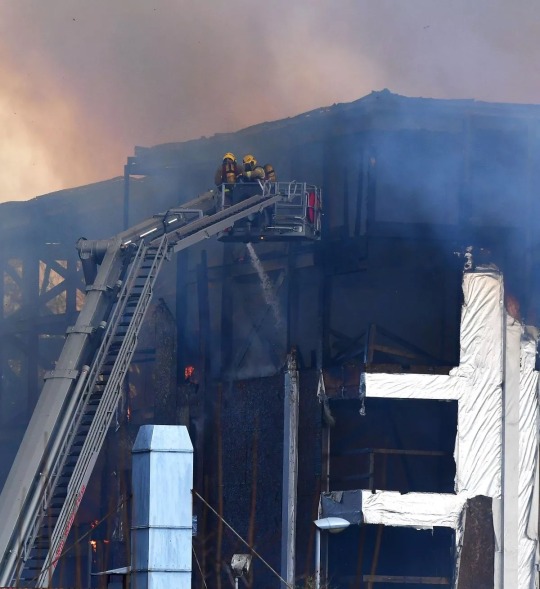
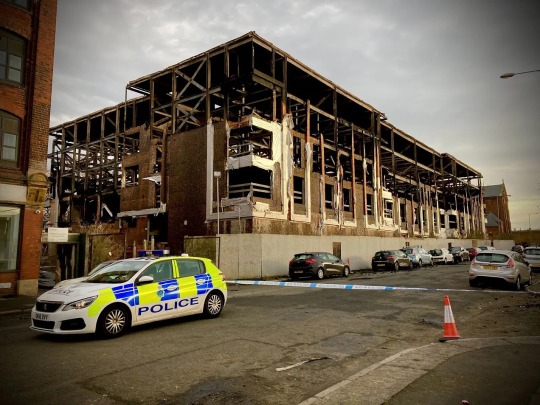
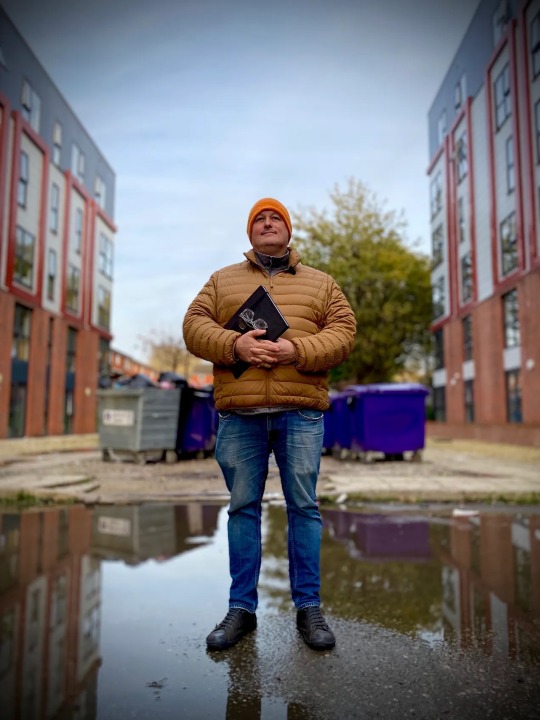
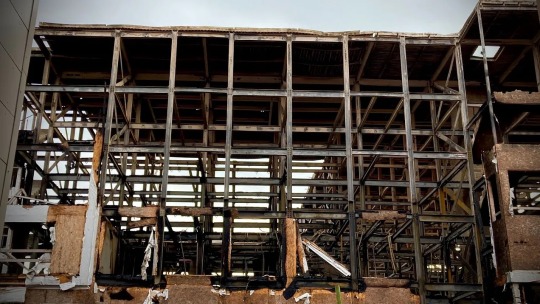
Village of the damned: Inside the Fox Street fire
Special investigation: For years, Matt O'Donoghue was told about major problems at a controversial development in Everton. Then the dire predictions came true. By Matt O’Donoghue.
“Block D is an inferno right now”, the first message reads. “Look what’s been torched.” More follow. “Not sure how other blocks are faring, they’ve been evacuated.” Some have video or photos attached. “Seen this. I feel sick.” One simply reads: “Fox Street’s final chapter.”
Block D at the stalled residential development of Fox Street Village sits on the edge of Everton. It is ablaze, and a lot of people want me to know. As the firefighters battle to hold back the flames that threaten to leap from block to block, frantic calls, dramatic videos, and heartbreaking messages light up my phone screen. Many of those getting in touch are people I met over the past five years I’ve been reporting on the sorry saga of Fox Street Village. They’re all saying the same thing: “It was only a matter of time.”
“Something like this had to happen,” says Chris Burridge, who owns one of the Fox Street Village apartments as he surveys the damage. It’s Sunday, January 28th and the day after the fire. Steel girders are bent and buckled like roller coaster tracks; the metal cools and creaks, and loose material flaps in the wind. “There’s been no decent perimeter fence for some time, even though we’ve been reporting incidents. We were lucky Block B didn’t go up. The flames and heat were ferocious. Mersey Fire saved those buildings.”
Lucky indeed. Fox Street Village was originally intended to be a 400 apartment complex spread across four blocks that were to be four or five stories tall. But Block D was never completed and has remained an unfinished shell for the past five years. The rest of the site, on the other hand, is home to a number of residents. Had the fire spread there, it would have been catastrophic. Letting agents are on-site to support tenants and help with the clean up, while insurance brokers and risk assessors mill about around them. Lifts, heating, and water are soon back on. Black debris litters the ground and the flat roofs of the adjacent blocks, while clumps of burnt insulation and wood continue to drift from above.
A team from Residence 365, the company that manages the Village’s interior communal areas, is helping to get residents back into their homes. “Unfortunately, as the fire started to take hold, many residents in Block A failed to evacuate,” says Carolyn Delaney, Residence 365’s managing director. “Police had to force their way into every apartment to make sure that building was clear and everyone was safe. Those doors and frames will have to be repaired.”
Outside, Block B’s walls and windows are warped from where it faced the fire. The cladding is buckled and wavy, like bad icing on an overbaked cake. Most of the glass is cracked and broken, and window frames have bowed out of shape. The fire breaks under the cladding will have activated and expanded. There will need to be a lot of work to put things right.
“The grounds and estate management company are nowhere”, says an exasperated Burridge. The last he was told, a company called Xenia Estates Limited were responsible for looking after the outside areas. “It’s outrageous. They’ve sent nobody down here to help or make things safe.”
Kevin Robertson-Hale is a local campaigner who set up the action group Everton Together. He was shopping at the ASDA on the Breck Road when he first saw the black clouds rising above his community. He knew straight away what was likely to be burning. “It’s just a miracle that nobody’s been hurt,” he says. Although Block D was not a finished building, homeless people have been sleeping there and using it as a shelter. “The way the place went up, someone asleep would never have got out.” Kevin is horrified by what has happened, but certainly not surprised. “We’ve been saying for years that something was going to happen. Either someone was going to fall off and break their neck, or it was going to go up in flames.”
Beneath the debris and behind the spectacular videos, the plumes of smoke billowing out and up from the bare bones of blazing Block D, are hundreds of stories of loss and despair. To properly understand what went wrong at Fox Street Village, to learn why things must be fixed, we have to understand why they were broken in the first place.
Between 1971 and 1991, Everton’s population dropped by 60% as the area’s fortunes and prospects charted exactly the decline of the British Empire. As Liverpool’s docks fell silent, the huge warehouses and the factories like Tate and Lyle and British American Tobacco were closed. Thousands of jobs disappeared and the communities that once relied upon those goods shipped from all corners of the Empire ceased to exist. An urgent need to improve the area’s housing conditions, the crumbling Victorian tenements, led to slum clearance and demolition on a massive scale. Those once solid communities were broken up with families moved out and housed in places like Kirby, Runcorn and Skelmersdale. It was the perfect storm; shops closed, tower blocks were pulled down and the city’s terminal decline was hastened by Margaret Thatcher’s vicious attempts to starve the upstart council controlled by Hatton’s Militant Tendency into surrender.
Fox Street Village followed the same controversial funding model that has dogged similar schemes across the city, known as ‘fractional sales’. Buyers — many based overseas — are enticed with the promise of a good rent and a solid investment in return for paying a large part of the sale price upfront. But as countless investors at other stalled sites in Liverpool have discovered to their detriment, there’s little or no protection should things go wrong.
When Fox Street Village Limited collapsed into administration, in 2019, it owed creditors £10 million and the city council nearly £700,000. The council told us that an invoice for over half a million pounds remains unpaid but that the building’s new owners will have to pick up that tab. Meanwhile, £6 million that investors had paid out for Block D was instead spent on a new fifth building the developers had added to their scheme. A search of records show creditors who had paid for apartments in Block D came from Birkenhead to Beijing and all points in between. With no money left to complete the job, and no cash to settle their bills, the steel frame and internal walls made of wood have remained open to the elements. The freehold to the site was sold to Manchester-based property investment company SGL1 Limited in 2020 for a reported £1.6 million. The site was split and a separate company run by the same two directors as SGL1 but called SGL3, took over the unfinished Block D. A series of complex court cases followed as buyers battled to gain control and finish the scheme. By 2021, the architect’s original drawings for Block D had been rebranded as “Park View” to be marketed at a new group of buyers. A one bed studio in the unfinished wood and steel shell was being advertised for £85,000. The Post is unsure how many people bought into this new scheme or whether their money is protected.
“I bought a three-bedroom apartment that cost £135,000, which was a really good deal. With hindsight, almost too good to be true. I’ve been firefighting one problem after another since day one.” November 8th, 2023 and I am rattling along the M62 with Chris Burridge. “It doesn’t look that good,” Chris says with detached stoicism and monumental understatement as Fox Street Village Block D comes into view. “It would be funny, if it wasn’t so costly and dangerous.” Chris is one of the apartment owners who have been battling over an £80,000 bill to install a transformer that would safely reconnect their electricity to the grid. The builders left a hot-wired connection into the mains, which Chris says the buyers only found out about after they’d secured the right to manage some of the site. It was just the latest in a long line of hidden surprises that have revealed themselves over the five years since tenants moved in. “The biggest block, Block D, is just a shell that should have been finished years ago,” Chris tells me as we pull up alongside what looks like a building entirely made of wood and wrapped in tin foil. “There should have been one large, shared entrance area, an underground car park for 170 vehicles, shops, a cinema room with communal laundry, and a bike store. All of those amenities were what made this site so attractive.”
Chris pauses to re-imagine what could have been, before reality kicks back in. “None of that exists. What we’ve actually got are great apartments next to the rat-infested fire trap of a mess that is Block D.”
By Matt O’Donoghue
“Block D is an inferno right now”, the first message reads. “Look what’s been torched.” More follow. “Not sure how other blocks are faring, they’ve been evacuated.” Some have video or photos attached. “Seen this. I feel sick.” One simply reads: “Fox Street’s final chapter.”
Block D at the stalled residential development of Fox Street Village sits on the edge of Everton. It is ablaze, and a lot of people want me to know. As the firefighters battle to hold back the flames that threaten to leap from block to block, frantic calls, dramatic videos, and heartbreaking messages light up my phone screen. Many of those getting in touch are people I met over the past five years I’ve been reporting on the sorry saga of Fox Street Village. They’re all saying the same thing: “It was only a matter of time.”
Chris Burridge on Fox Street. Photo: Matt O’Donoghue.
“Something like this had to happen,” says Chris Burridge, who owns one of the Fox Street Village apartments as he surveys the damage. It’s Sunday, January 28th and the day after the fire. Steel girders are bent and buckled like roller coaster tracks; the metal cools and creaks, and loose material flaps in the wind. “There’s been no decent perimeter fence for some time, even though we’ve been reporting incidents. We were lucky Block B didn’t go up. The flames and heat were ferocious. Mersey Fire saved those buildings.”
Lucky indeed. Fox Street Village was originally intended to be a 400 apartment complex spread across four blocks that were to be four or five stories tall. But Block D was never completed and has remained an unfinished shell for the past five years. The rest of the site, on the other hand, is home to a number of residents. Had the fire spread there, it would have been catastrophic. Letting agents are on-site to support tenants and help with the clean up, while insurance brokers and risk assessors mill about around them. Lifts, heating, and water are soon back on. Black debris litters the ground and the flat roofs of the adjacent blocks, while clumps of burnt insulation and wood continue to drift from above.
A team from Residence 365, the company that manages the Village’s interior communal areas, is helping to get residents back into their homes. “Unfortunately, as the fire started to take hold, many residents in Block A failed to evacuate,” says Carolyn Delaney, Residence 365’s managing director. “Police had to force their way into every apartment to make sure that building was clear and everyone was safe. Those doors and frames will have to be repaired.”
Outside, Block B’s walls and windows are warped from where it faced the fire. The cladding is buckled and wavy, like bad icing on an overbaked cake. Most of the glass is cracked and broken, and window frames have bowed out of shape. The fire breaks under the cladding will have activated and expanded. There will need to be a lot of work to put things right.
“The grounds and estate management company are nowhere”, says an exasperated Burridge. The last he was told, a company called Xenia Estates Limited were responsible for looking after the outside areas. “It’s outrageous. They’ve sent nobody down here to help or make things safe.”
Subscribe
Kevin Robertson-Hale is a local campaigner who set up the action group Everton Together. He was shopping at the ASDA on the Breck Road when he first saw the black clouds rising above his community. He knew straight away what was likely to be burning. “It’s just a miracle that nobody’s been hurt,” he says. Although Block D was not a finished building, homeless people have been sleeping there and using it as a shelter. “The way the place went up, someone asleep would never have got out.” Kevin is horrified by what has happened, but certainly not surprised. “We’ve been saying for years that something was going to happen. Either someone was going to fall off and break their neck, or it was going to go up in flames.”
Beneath the debris and behind the spectacular videos, the plumes of smoke billowing out and up from the bare bones of blazing Block D, are hundreds of stories of loss and despair. To properly understand what went wrong at Fox Street Village, to learn why things must be fixed, we have to understand why they were broken in the first place.
The building on Fox Street. Photo: Chris Burridge
Between 1971 and 1991, Everton’s population dropped by 60% as the area’s fortunes and prospects charted exactly the decline of the British Empire. As Liverpool’s docks fell silent, the huge warehouses and the factories like Tate and Lyle and British American Tobacco were closed. Thousands of jobs disappeared and the communities that once relied upon those goods shipped from all corners of the Empire ceased to exist. An urgent need to improve the area’s housing conditions, the crumbling Victorian tenements, led to slum clearance and demolition on a massive scale. Those once solid communities were broken up with families moved out and housed in places like Kirby, Runcorn and Skelmersdale. It was the perfect storm; shops closed, tower blocks were pulled down and the city’s terminal decline was hastened by Margaret Thatcher’s vicious attempts to starve the upstart council controlled by Hatton’s Militant Tendency into surrender.
Stand on the edge of Fox Street today and look towards the gleaming glass skyscrapers and modern penthouses and it’s obvious, the regeneration that has breathed new life into other parts of Liverpool in recent years seems to run out of steam as it creeps towards this area’s streets. According to the last census, Everton West — where Fox Street Village sits — has the third highest numbers of children on free school meals. This neighbourhood has some of the poorest health indicators, including the lowest life expectancy, across the whole of the city.
As Liverpool’s reputation grew as a great place to study, the last decade has seen residential housing for the influx of students become the city’s short-term planning solution and a way to kickstart Everton’s economy.
Fox Street Village followed the same controversial funding model that has dogged similar schemes across the city, known as ‘fractional sales’. Buyers — many based overseas — are enticed with the promise of a good rent and a solid investment in return for paying a large part of the sale price upfront. But as countless investors at other stalled sites in Liverpool have discovered to their detriment, there’s little or no protection should things go wrong.
When Fox Street Village Limited collapsed into administration, in 2019, it owed creditors £10 million and the city council nearly £700,000. The council told us that an invoice for over half a million pounds remains unpaid but that the building’s new owners will have to pick up that tab. Meanwhile, £6 million that investors had paid out for Block D was instead spent on a new fifth building the developers had added to their scheme. A search of records show creditors who had paid for apartments in Block D came from Birkenhead to Beijing and all points in between. With no money left to complete the job, and no cash to settle their bills, the steel frame and internal walls made of wood have remained open to the elements. The freehold to the site was sold to Manchester-based property investment company SGL1 Limited in 2020 for a reported £1.6 million. The site was split and a separate company run by the same two directors as SGL1 but called SGL3, took over the unfinished Block D. A series of complex court cases followed as buyers battled to gain control and finish the scheme. By 2021, the architect’s original drawings for Block D had been rebranded as “Park View” to be marketed at a new group of buyers. A one bed studio in the unfinished wood and steel shell was being advertised for £85,000. The Post is unsure how many people bought into this new scheme or whether their money is protected.
“I bought a three-bedroom apartment that cost £135,000, which was a really good deal. With hindsight, almost too good to be true. I’ve been firefighting one problem after another since day one.” November 8th, 2023 and I am rattling along the M62 with Chris Burridge. “It doesn’t look that good,” Chris says with detached stoicism and monumental understatement as Fox Street Village Block D comes into view. “It would be funny, if it wasn’t so costly and dangerous.” Chris is one of the apartment owners who have been battling over an £80,000 bill to install a transformer that would safely reconnect their electricity to the grid. The builders left a hot-wired connection into the mains, which Chris says the buyers only found out about after they’d secured the right to manage some of the site. It was just the latest in a long line of hidden surprises that have revealed themselves over the five years since tenants moved in. “The biggest block, Block D, is just a shell that should have been finished years ago,” Chris tells me as we pull up alongside what looks like a building entirely made of wood and wrapped in tin foil. “There should have been one large, shared entrance area, an underground car park for 170 vehicles, shops, a cinema room with communal laundry, and a bike store. All of those amenities were what made this site so attractive.”
Chris pauses to re-imagine what could have been, before reality kicks back in. “None of that exists. What we’ve actually got are great apartments next to the rat-infested fire trap of a mess that is Block D.”
Residents in this area have been complaining to me about the rats for as long as I’ve been investigating Fox Street Village. Back in April 2019, I broke my first story on the slow-motion car crash that has taken place here — months of work as part of an ongoing investigation for ITV’s Granada Reports. Back then, tenant Ross Lowey told me on camera: “We don’t feel safe. Every time we come back round that corner, we expect to see flames coming out of it.” He was far from alone in his unhappy prophecy.
Six months before that first ITV News report, in November 2018, I had been on a separate investigation into how developers duck out of paying the millions they owed to their cash-strapped council. It suddenly took an unexpected twist. While I ploughed through a mountain of conflicting planning documents that link to this case, a buyer tipped me off that their building was about to be the first on Merseyside to be shut down and issued with a Prohibition Notice. It was the last-ditch resort for a city council that had run out of ideas on how to make this site safe. “Serious construction issues will contribute to the spread of fire,” the Prohibition Notice reads. “Fire will spread quickly and possibly unnoticed.”
Put simply, the problems that the buyers had uncovered at their completed flats were so severe that they put lives at risk. While Block D remained unfinished, three of the four blocks that people had already moved into were so dangerous that everyone would be forced to move out — immediately. Judge Lloyd would later brand the project “disgraceful” as she fined the developers £3,120 for breaching planning conditions. She expressed sympathy for the residents and investors who had been affected. Planning inspectors said the development was “poorly finished” and failed to meet standards. Those problems have cost hundreds of thousands of pounds to put right.
3
By Matt O’Donoghue
“Block D is an inferno right now”, the first message reads. “Look what’s been torched.” More follow. “Not sure how other blocks are faring, they’ve been evacuated.” Some have video or photos attached. “Seen this. I feel sick.” One simply reads: “Fox Street’s final chapter.”
Block D at the stalled residential development of Fox Street Village sits on the edge of Everton. It is ablaze, and a lot of people want me to know. As the firefighters battle to hold back the flames that threaten to leap from block to block, frantic calls, dramatic videos, and heartbreaking messages light up my phone screen. Many of those getting in touch are people I met over the past five years I’ve been reporting on the sorry saga of Fox Street Village. They’re all saying the same thing: “It was only a matter of time.”
Chris Burridge on Fox Street. Photo: Matt O’Donoghue.
“Something like this had to happen,” says Chris Burridge, who owns one of the Fox Street Village apartments as he surveys the damage. It’s Sunday, January 28th and the day after the fire. Steel girders are bent and buckled like roller coaster tracks; the metal cools and creaks, and loose material flaps in the wind. “There’s been no decent perimeter fence for some time, even though we’ve been reporting incidents. We were lucky Block B didn’t go up. The flames and heat were ferocious. Mersey Fire saved those buildings.”
Lucky indeed. Fox Street Village was originally intended to be a 400 apartment complex spread across four blocks that were to be four or five stories tall. But Block D was never completed and has remained an unfinished shell for the past five years. The rest of the site, on the other hand, is home to a number of residents. Had the fire spread there, it would have been catastrophic. Letting agents are on-site to support tenants and help with the clean up, while insurance brokers and risk assessors mill about around them. Lifts, heating, and water are soon back on. Black debris litters the ground and the flat roofs of the adjacent blocks, while clumps of burnt insulation and wood continue to drift from above.
A team from Residence 365, the company that manages the Village’s interior communal areas, is helping to get residents back into their homes. “Unfortunately, as the fire started to take hold, many residents in Block A failed to evacuate,” says Carolyn Delaney, Residence 365’s managing director. “Police had to force their way into every apartment to make sure that building was clear and everyone was safe. Those doors and frames will have to be repaired.”
Outside, Block B’s walls and windows are warped from where it faced the fire. The cladding is buckled and wavy, like bad icing on an overbaked cake. Most of the glass is cracked and broken, and window frames have bowed out of shape. The fire breaks under the cladding will have activated and expanded. There will need to be a lot of work to put things right.
“The grounds and estate management company are nowhere”, says an exasperated Burridge. The last he was told, a company called Xenia Estates Limited were responsible for looking after the outside areas. “It’s outrageous. They’ve sent nobody down here to help or make things safe.”
Subscribe
Kevin Robertson-Hale is a local campaigner who set up the action group Everton Together. He was shopping at the ASDA on the Breck Road when he first saw the black clouds rising above his community. He knew straight away what was likely to be burning. “It’s just a miracle that nobody’s been hurt,” he says. Although Block D was not a finished building, homeless people have been sleeping there and using it as a shelter. “The way the place went up, someone asleep would never have got out.” Kevin is horrified by what has happened, but certainly not surprised. “We’ve been saying for years that something was going to happen. Either someone was going to fall off and break their neck, or it was going to go up in flames.”
Beneath the debris and behind the spectacular videos, the plumes of smoke billowing out and up from the bare bones of blazing Block D, are hundreds of stories of loss and despair. To properly understand what went wrong at Fox Street Village, to learn why things must be fixed, we have to understand why they were broken in the first place.
The building on Fox Street. Photo: Chris Burridge
Between 1971 and 1991, Everton’s population dropped by 60% as the area’s fortunes and prospects charted exactly the decline of the British Empire. As Liverpool’s docks fell silent, the huge warehouses and the factories like Tate and Lyle and British American Tobacco were closed. Thousands of jobs disappeared and the communities that once relied upon those goods shipped from all corners of the Empire ceased to exist. An urgent need to improve the area’s housing conditions, the crumbling Victorian tenements, led to slum clearance and demolition on a massive scale. Those once solid communities were broken up with families moved out and housed in places like Kirby, Runcorn and Skelmersdale. It was the perfect storm; shops closed, tower blocks were pulled down and the city’s terminal decline was hastened by Margaret Thatcher’s vicious attempts to starve the upstart council controlled by Hatton’s Militant Tendency into surrender.
Stand on the edge of Fox Street today and look towards the gleaming glass skyscrapers and modern penthouses and it’s obvious, the regeneration that has breathed new life into other parts of Liverpool in recent years seems to run out of steam as it creeps towards this area’s streets. According to the last census, Everton West — where Fox Street Village sits — has the third highest numbers of children on free school meals. This neighbourhood has some of the poorest health indicators, including the lowest life expectancy, across the whole of the city.
As Liverpool’s reputation grew as a great place to study, the last decade has seen residential housing for the influx of students become the city’s short-term planning solution and a way to kickstart Everton’s economy.
Fox Street Village followed the same controversial funding model that has dogged similar schemes across the city, known as ‘fractional sales’. Buyers — many based overseas — are enticed with the promise of a good rent and a solid investment in return for paying a large part of the sale price upfront. But as countless investors at other stalled sites in Liverpool have discovered to their detriment, there’s little or no protection should things go wrong.
When Fox Street Village Limited collapsed into administration, in 2019, it owed creditors £10 million and the city council nearly £700,000. The council told us that an invoice for over half a million pounds remains unpaid but that the building’s new owners will have to pick up that tab. Meanwhile, £6 million that investors had paid out for Block D was instead spent on a new fifth building the developers had added to their scheme. A search of records show creditors who had paid for apartments in Block D came from Birkenhead to Beijing and all points in between. With no money left to complete the job, and no cash to settle their bills, the steel frame and internal walls made of wood have remained open to the elements. The freehold to the site was sold to Manchester-based property investment company SGL1 Limited in 2020 for a reported £1.6 million. The site was split and a separate company run by the same two directors as SGL1 but called SGL3, took over the unfinished Block D. A series of complex court cases followed as buyers battled to gain control and finish the scheme. By 2021, the architect’s original drawings for Block D had been rebranded as “Park View” to be marketed at a new group of buyers. A one bed studio in the unfinished wood and steel shell was being advertised for £85,000. The Post is unsure how many people bought into this new scheme or whether their money is protected.
Fox Street after the fire. Photo: Chris Burridge
“I bought a three-bedroom apartment that cost £135,000, which was a really good deal. With hindsight, almost too good to be true. I’ve been firefighting one problem after another since day one.” November 8th, 2023 and I am rattling along the M62 with Chris Burridge. “It doesn’t look that good,” Chris says with detached stoicism and monumental understatement as Fox Street Village Block D comes into view. “It would be funny, if it wasn’t so costly and dangerous.” Chris is one of the apartment owners who have been battling over an £80,000 bill to install a transformer that would safely reconnect their electricity to the grid. The builders left a hot-wired connection into the mains, which Chris says the buyers only found out about after they’d secured the right to manage some of the site. It was just the latest in a long line of hidden surprises that have revealed themselves over the five years since tenants moved in. “The biggest block, Block D, is just a shell that should have been finished years ago,” Chris tells me as we pull up alongside what looks like a building entirely made of wood and wrapped in tin foil. “There should have been one large, shared entrance area, an underground car park for 170 vehicles, shops, a cinema room with communal laundry, and a bike store. All of those amenities were what made this site so attractive.”
Chris pauses to re-imagine what could have been, before reality kicks back in. “None of that exists. What we’ve actually got are great apartments next to the rat-infested fire trap of a mess that is Block D.”
The author Matt O’Donoghue on ITV. Photo: ITC/IMDb.
Residents in this area have been complaining to me about the rats for as long as I’ve been investigating Fox Street Village. Back in April 2019, I broke my first story on the slow-motion car crash that has taken place here — months of work as part of an ongoing investigation for ITV’s Granada Reports. Back then, tenant Ross Lowey told me on camera: “We don’t feel safe. Every time we come back round that corner, we expect to see flames coming out of it.” He was far from alone in his unhappy prophecy.
Six months before that first ITV News report, in November 2018, I had been on a separate investigation into how developers duck out of paying the millions they owed to their cash-strapped council. It suddenly took an unexpected twist. While I ploughed through a mountain of conflicting planning documents that link to this case, a buyer tipped me off that their building was about to be the first on Merseyside to be shut down and issued with a Prohibition Notice. It was the last-ditch resort for a city council that had run out of ideas on how to make this site safe. “Serious construction issues will contribute to the spread of fire,” the Prohibition Notice reads. “Fire will spread quickly and possibly unnoticed.”
Put simply, the problems that the buyers had uncovered at their completed flats were so severe that they put lives at risk. While Block D remained unfinished, three of the four blocks that people had already moved into were so dangerous that everyone would be forced to move out — immediately. Judge Lloyd would later brand the project “disgraceful” as she fined the developers £3,120 for breaching planning conditions. She expressed sympathy for the residents and investors who had been affected. Planning inspectors said the development was “poorly finished” and failed to meet standards. Those problems have cost hundreds of thousands of pounds to put right.
Subscribe
The council say that it was only after the buildings were largely constructed that it became apparent there was a failure to comply with conditions or the plans that had been passed. When the new owners submitted another application to make up for the missing car park, a fresh deal was struck for them to pay towards a cycle route and parking scheme. But planning approval was refused when no money was forthcoming.
Two companies were involved in the development of Fox Street Village: Linmari Construction Limited and Fox Street Village Limited. Both were run by company director, Gary Howard. In 2013, Howard was left as the sole director of Fox Street Student Halls Limited after his business partner, Lee Carroll, was forced to step down. Carroll had been found guilty of being a gang master under legislation brought in to tackle labour exploitation after an investigation into a recruitment company that Carroll ran with John Howard. Carroll was banned from being a company director for 12 years.
While nothing should be inferred from Gary Howard’s previous business history, six companies where he was a director and shareholder have a County Court Judgement against them. Just like Fox Street Village Limited, seven firms that Howard also once helped run have gone into administration owing money to creditors — two of which were also residential developments in Liverpool designed for student living. We’ve been unable to contact Mr Howard for a comment.
“The frameworks that are supposed to deliver safe buildings, protect their owners and keep those inside safe are not up to the job,” says Dr Len Gibbs, whose doctoral thesis focused on the problems with unfinished developments in the Liverpool area.
That regulatory framework — to get a building through from an architect’s drawings to the point of being occupied — can be roughly broken down into two stages: planning and building control. The first part is strictly controlled by rules and regulations that must be met and followed to the letter. A council department controls the planning process, and everything has to be approved by a committee after a rigorous assessment by trained officers. Once it passes and everybody agrees that the buildings are what the council and community needs, the proposals are said to have ‘gained consent’.
When developers have their planning consent, a building control team comes on board to oversee every step of the construction. Site inspectors visit to approve stages such as the foundations and drains, and the relevant paperwork is filed with the city council to confirm everything has progressed according to the plans that were submitted and in accordance with the required regulations. In theory, these two functions operate independently but in support of one another to deliver a building that doesn’t kill the people who move in.
That’s something of a simplification, but these are incredibly complex areas that require years of training to properly understand. Only when every step has been followed can a completion certificate be issued against the building and each individual apartment. These final pieces of paper confirm that everything is up to standard and legally ready for tenants to move in. If all these steps are followed correctly, then a development of buildings that were once judged to be a threat to the lives of residents should never be occupied. Yet they were occupied.
#liverpoolstudentlettings#Liverpool student letting#2024#fire#Liverpool echo#fox street studios#video#viralpost#liverpool#student#Liverpool students#January 2024#blaze#merseyside#Fox Street Village#Matt O'Donoghue#itv
8 notes
·
View notes
Text
A Guided Tour of the Fortress Blizzardpaddles

Starting from the top of the fortress, I have a mist generator on the roof

Above the entrance I have a public tavern and a small library. Archer towers surround my fort, though they've never been put to use.

Before the archer towers, I build this platform for my archers. Also never used. The platform in the center was originally just meant to keep snow and rain from falling into the fortress.

At ground level, we have corpse and refuse stockpiles, beehives, nest boxes, and a garden.
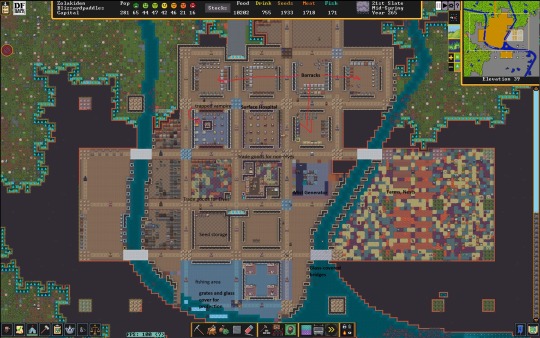
On the main floor, we have the trade depot right at the entrance. I separate my trade goods into two stockpiles: one for elves, and one for everyone else. I recently overhauled my military and relocated some of the barracks and archery ranges. at the south is my fishery, which is protected with iron grates in the river and glass blocks above. I'm not sure why but I have perpetual ice in the river. To the east are some new farms I'm building to scale up my dye and cloth production. I also have my surface hospital here, seed storage, and a mist generator.
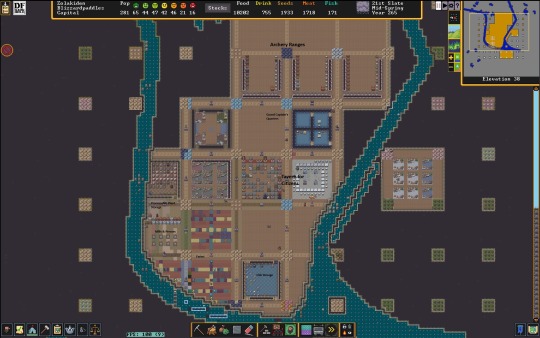
Below I have archery ranges, soap making, my citizen's/residents tavern (recently rearranged) milling and pressing, farms, and farmer workshops. I'm proud of that tower sticking up out of the water. The river here freezes from mid-autumn to early spring but it was a race against the clock to get that watertight.
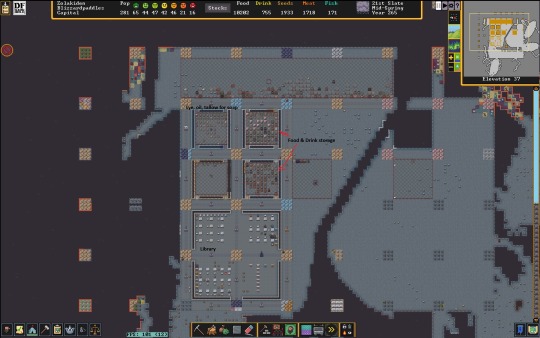
Here I have food & Drink storage for the tavern above. I also have a large library with hundreds of written works. Beneath the soapmakers workshops is a stockpile of lye, oil, and tallow. Below the farmers workshops is a stockpile for wool, milk, and processable plants.

Food and drink production, including butchers, ashery (supplying lye upwards), stills, and kitchens.
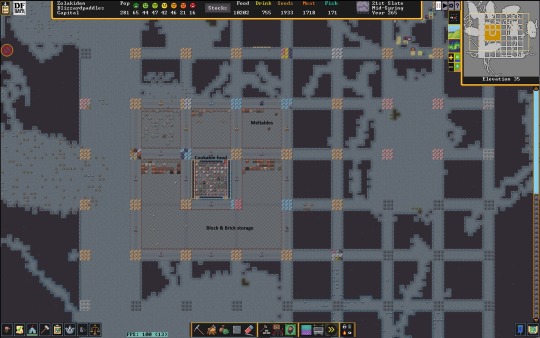
Storage and supplies for food & drink production, and block & brick storage. meltable objects are above the smelters for recycling.
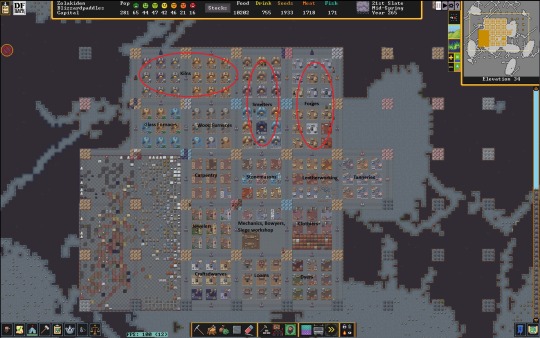
Manufacturing level. I try to keep workshops grouped by supply chain, with stockpiles above and below in a way that makes sense. See below for an example.
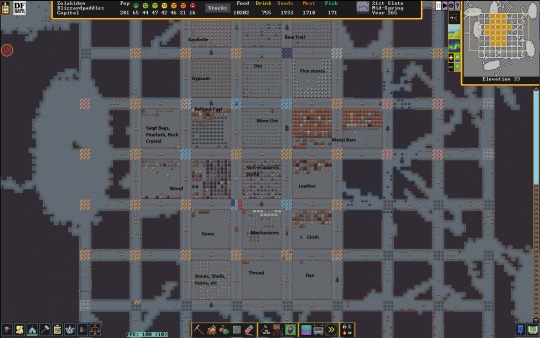
Wood feeds the carpenters and the wood furnace. Fuel is near all the furnaces, kilns, and forges. Textile industry is grouped together. This requires quite a bit of planning, and learning from experience from previous forts.
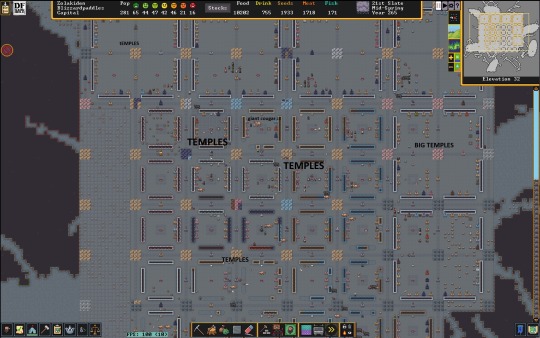
TEMPLES! I started making quadruple-size temples for the faiths with ~100 followers, because the smaller ones were getting very crowded. Every temple has a bunch of instruments, and almost all of them have a dedicated performer. The large temples are built with steel block walls.

Nobles apartments, and museum.

Guildhalls. I'm starting to build more even if the guilds aren't established yet. As my economy grows more complex, there are a lot more job titles, so there are fewer guilds being established.
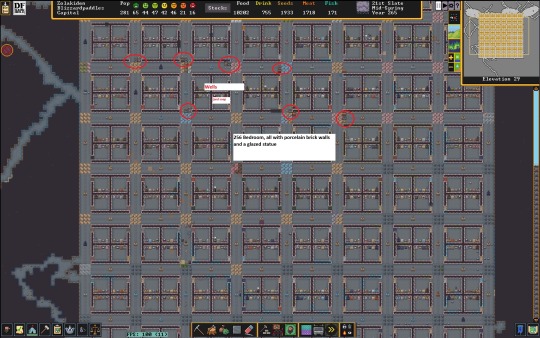
Residential quarter. This is my first time giving everyone a 4x4 bedroom. I used to do 1x3 bedrooms, which allowed me to fit 12 rooms per block. I think the dwarves prefer the extra space though. I spent several years renovating the bedrooms by replacing stone walls with porcelain brick, and they LOVE it!

Tombs. Too many tombs. Most of them are full, a lot of them are pets though. My dungeons is here, with my Cask of Amontillado'd werelizard in the northeast corner.

And finally, several layers below, is my cavern hospital. It's really nice to have a second hospital down below for when the Amphibian Folk come and fuck with us.
That's all for this fort. My FPS hovers between 8 and 15 so it takes about 15 hours to go through a single year. I don't want to be done with it, but it's getting unbearably slow.
26 notes
·
View notes
Text
Is Steel Roofing the Future for Residential Housing?
In the scorching heat and unpredictable storms of Dallas, a sturdy roof is not just a luxury—it's a necessity. Protecting your home from the elements requires the right roofing material, and in recent years, residential steel roofing has emerged as a top contender. Here's why:
5 Compelling Reasons to Choose Residential Steel Roofing
Sustainability: With a growing emphasis on eco-friendly practices, steel roofing shines as a sustainable choice. Its energy-efficient properties help reduce utility bills by reflecting heat, while manufacturers are increasingly adopting green production methods. By opting for steel, homeowners can contribute to a greener future while enjoying long-term savings.
Durability: When it comes to longevity, steel roofing stands the test of time. Built to resist corrosion and withstand the harshest weather conditions, a well-installed steel roof can protect your home for up to fifty years or more. With proper ventilation and maintenance, you can count on your steel roof to provide reliable protection year after year.
Weather Resistance: From scorching summers to torrential downpours, Dallas weather can be unforgiving. Fortunately, steel roofing is up to the challenge. Its resilience against extreme weather ensures your home remains safe and secure, offering superior insulation in winter and heat reflection in summer. Say goodbye to costly weather-related repairs and hello to peace of mind.
Easy Installation: Time is of the essence when it comes to roofing projects, and steel roofing delivers on efficiency. Compared to traditional materials, steel roofs are quick and straightforward to install, minimizing disruption to your daily life. With professional installation, you can enjoy the benefits of your new roof sooner rather than later.
In Conclusion:
The rise of residential steel roofing in Dallas is no coincidence. With its unbeatable combination of sustainability, durability, weather resistance, and ease of installation, steel roofing offers homeowners a smart investment in the future of their homes.
If you're considering making the switch to steel roofing, be sure to consult with experienced professionals to ensure a seamless installation process and maximum performance. With steel roofing, you're not just protecting your home—you're investing in lasting peace of mind.
1 note
·
View note
Text
Whats's LSF ?

Light Steel Framing (LSF) is a construction method using lightweight, prefabricated steel sections for walls, floors, and roofs. It is durable, eco-friendly, and offers design flexibility with fast, cost-effective construction. Common in residential, commercial, and modular buildings, LSF reduces waste, labor, and environmental impact.
2 notes
·
View notes
Text


Game Secrets Institute - Jet Set Radio on Game Players magazine Vol.133 (Video game magazine)(Hong Kong)(12/08/2000)
Translation in English:
DC (Dreamcast)
Manufacturer: SEGA Price: 5800 Yen Capacity: GD-ROM X 1 Memory: 4 BLOCKS Release date: on sale 1P/ETC/MODEM, VMS, vibration PACK, VGA BOX correspondence
JET SET RADIO DATASET
DO YOU REMEMBER THAT I SAID IN THE GAME INTRODUCTION OF ISSUE 131 THAT THIS JET SET RADIO HAS SOMETHING CALLED THE "JET SET LOGO"? These signs allow players to change the patterns of the current character when the game, and the entire game has 90 Jet Set logos. I believe that many players have not stored all patterns. Therefore, I will send you the location of all 90 "JET SET Logo" in this issue, plus some special information.
The first level (Shibuya GG)(Shibuya-cho)(Stage 1)- Number of JET SET logos (5)
Logo No. - Place:
No.11 - Platform above convenience store No.15 - Lamp Post Top No.41 - Next to the billboard No.45 - Under the Flyover No.71 - Under the Flyover
First encounter with the red gang (Love trap)(Shibuya-cho)(Stage 2) - Number of JET SET logos (7)
Logo No. - Place:
No.13 - Residential roof No.16 - Over the road No.43 - Above the park to the broken bridge No.46 - Broken bridge and high altitude No.72 - Roof next to the broken bridge No.73 - Under the broken bridge No.75 - On the traffic sign next to the park
Strange Group (The monster of Kogane)(Kogane-cho)(Stage 3) - Number of JET SET logos (8)
Logo No. - Place:
No.18 - Near the boat behind the starting point No.20 - The steel bars movement on the way No.22 - Residential roof No.48 - Residential house No.51 - In the alley No.77 - Over the railing No.79 - Next to the oil depot No.80 - Near the starting point
Fighting the Strange Group (No.540)(Kogane-cho)(Stage 4)- Number of JET SET logos (4)
Logo No. - Place:
No.17 - Over the fence next to the starting point No.21 - The end of the upper tunnel in the workshop No.50 - Wires above the workshop No.78 - Factory roof
Dueling the Strange Group (Kogane Circus)(Kogane-cho)(Stage 5) - Number of JET SET logos (3)
Logo No. - Place:
No.19 - Inside the hidden tunnel No.47 - Sewer tunnel in the air No.76 - Sewerage tunnel
First encounter with the Mechanical Corps (Benten Boogie)(Benten-cho)(Stage 6) - Number of JET SET logos (3)
Logo No. - Place:
No.24 - Residential roof No.52 - Above the starting point No.82 - Inside the underground tunnel
Fighting the Mechanical Corps (Graffiti high)(Benten-cho)(Stage 7) - Number of JET SET logos (7)
Logo No. - Place:
No.25 - Top of the Dome Square store No.53 - Near the movie bulletin board No.54 - Over the shopping street tunnel No.55 - Over the flyover above the starting point No.83 - Dome Square on the wire No.84 - Top of a store in Shopping Street No.85 - On the container next to the starting point
The end of the Mechanical Corps (Noise Reduction)(Benten-cho)(Stage 8) - Number of JET SET logos (8)
Logo No. - Place:
No.23 - Over the road No.56 - Among the trees No.57 - The two bridges are connected in the air No.86 - Over the footbridge No.87 - Over the footbridge
The final battle with the red gang (Love attack)(Shibuya-cho)(Stage 9) - Number of JET SET logos (5)
Logo No. - Place:
No.12 - On the road No.14 - Billboard No.42 - Road No.44 - On the stairs No.74 - On the store platform
Battle of the Flying Forces(Fight or Flight)(Kogane-cho)(Stage 11)- Number of JET SET logos (2)
Logo No. - Place:
No.49 - Rooftop position No.81 - Rooftop position
The last level of the map for joint supply(Benten Burning)(Benten-cho)(Stage 12)- Number of JET SET logos (2)
Logo No. - Place:
No.26 - Inside the subway passage No.27 - Attached to the patio of the subway station
These are the locations of all 90 JET SET logos, 51 in total, and the remaining 39 are obtained after joining the character and obtaining a hidden character.
Three Hidden Characters
The game has ten basic characters for use, in fact, there are three hidden characters, and the method of obtaining these three hidden characters is very difficult, the method is that the player has to obtain all the version of the score "ジェット(Jet)" after the completion of the game will be released to play the role of the selection of the screen on a wall will be thumbs to the three logos, as long as you select these three logos can be selected to use these three hidden characters.
21 notes
·
View notes
Text
Cool roofing systems can reflect visible, infrared and ultraviolet wavelengths of sun and can release a large percentage of absorbed heat.
#epdm roofing installation#roof repairs#roofing contractor#tpo roofing contractor#commercial steel roofing#residential roofing#commercial roof installation
0 notes
Text
Alpine Roofing Construction

Alpine Roofing Construction, a Dallas TX-based roofing company, has proudly served customers in the greater Dallas-Fort Worth area with commercial and residential roofing since 1999. We specialize in installing, repairing, and maintaining all types of commercial roofing systems, including flat and low-sloped roofs, steeply sloped roofs, and options like single-ply, metal roofing, stone-coated steel, and TPO roofing.
We also replace residential roofs using high-quality materials like standing seam, slate, tile, and copper. For top-quality roofing services, tailored for our region’s harsh climate, and exceptional customer service, contact Alpine Roofing Construction today.
2 notes
·
View notes